Getting Started with Windows Forms Ribbon (RibbonControlAdv)
4 Feb 202524 minutes to read
This section explains how to implement a similar UI as Microsoft Outlook using WinForms Ribbon.
Add RibbonControlAdv in Designer
- Drag and drop the ‘RibbonControlAdv’ from toolbox to designer. The required assembly references will be added automatically. It will generate the Ribbon as shown below:
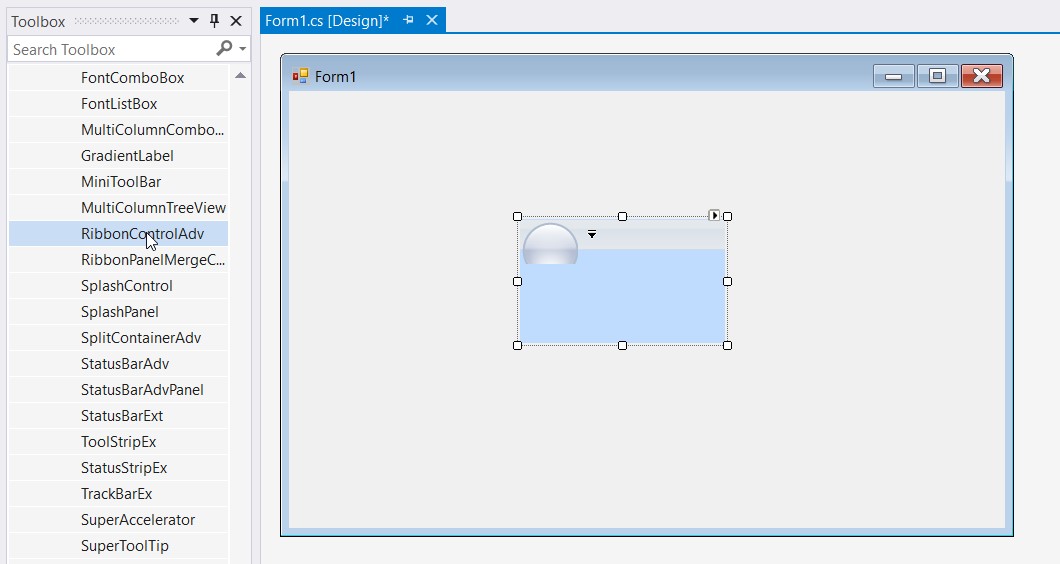
Add RibbonControlAdv in Code
To add the RibbonControlAdv manually through code, follow the below steps.
-
Add the below required assembly reference to the project,
- Syncfusion.Shared.Base
- Syncfusion.Tools.Windows
-
New ‘RibbonControlAdv’ can be added to the forms using the
Controls.Addmethod. Create a new Ribbon control and initialize the ribbon and then add it to the Controls using below code.//Adding a new ribbon control private Syncfusion.Windows.Forms.Tools.RibbonControlAdv ribbonControlAdv1; //Declare and initialize the new ribbon control this.ribbonControlAdv1 = new RibbonControlAdv(); //Adding ribbon control to form this.Controls.Add(ribbonControlAdv1);Private ribbonControlAdv1 As Syncfusion.Windows.Forms.Tools.RibbonControlAdv Default Private Property Item(ByVal Optional As ribbonControlAdv1 = New RibbonControlAdv()) As Me.Controls.Add(ribbonControlAdv1)
Configure RibbonForm
RibbonForm enables a similar look and feel of Microsoft Office. This section will guide you in applying different visual styles to RibbonControlAdv using RibbonForm.
By default, the Form in application will extend to Form class. Add the respective namespace and programmatically change it as RibbonForm class.
using Syncfusion.Windows.Forms.Tools;
public partial class Form1 : RibbonFormImports Syncfusion.Windows.Forms.Tools
Public Partial Class Form1
Inherits RibbonForm
End ClassApplying Visual Style
RibbonControlAdv appearance can be enhanced by using the RibbonStyle property of the Ribbon Control.
The following styles are supported by the Ribbon control.
- Office2007
- Office2010
- Office2013
- Office2016
- TouchStyle
The following code example illustrates how to set style for the RibbonControlAdv through code.
this.ribbonControlAdv1.RibbonStyle = RibbonStyle.Office2016;Me.ribbonControlAdv1.RibbonStyle = RibbonStyle.Office2016
Add Tabs to Ribbon
RibbonControlAdv lets you to create ToolStripTabItems easily using the smart tag. It also adds a RibbonPanel to which ToolStripItems can be added.
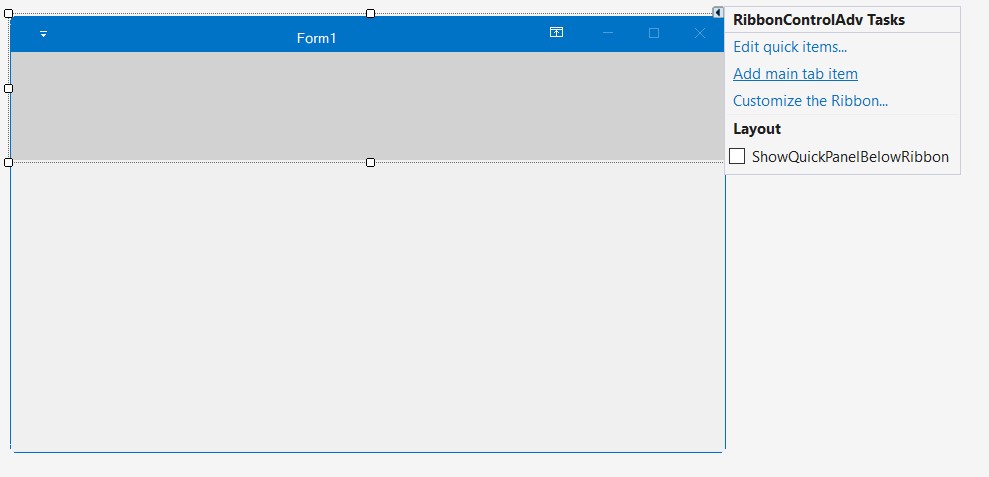
Customize the Tab item using the property grid.
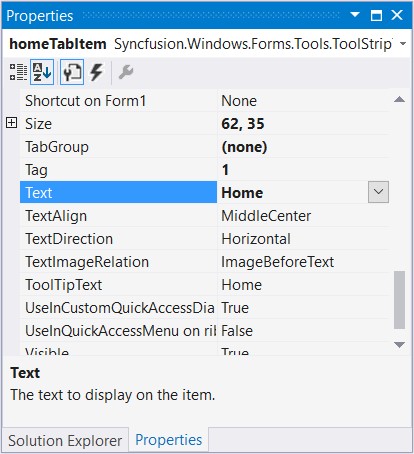
A new TabItem can be added to the RibbonControlAdv programmatically using the AddMainItem method. Create a ToolStripTabItem and then add it to the RibbonControlAdv using the below method.
// Adding a new Tab Item
private Syncfusion.Windows.Forms.Tools.ToolStripTabItem homeTabItem;
private Syncfusion.Windows.Forms.Tools.ToolStripTabItem sendTabItem;
private Syncfusion.Windows.Forms.Tools.ToolStripTabItem folderTabItem;
private Syncfusion.Windows.Forms.Tools.ToolStripTabItem viewTabItem;
//Declare and initialize a ToolStripTabItem
this.homeTabItem = new ToolStripTabItem();
this.sendTabItem = new ToolStripTabItem();
this.folderTabItem = new ToolStripTabItem();
this.viewTabItem = new ToolStripTabItem();
this.homeTabItem.Text = "Home";
this.sendTabItem.Text = "Send";
this.folderTabItem.Text = "Folder";
this.viewTabItem.Text = "View";
//Add the tab item to the RibbonControlAdv
this.ribbonControlAdv1.Header.AddMainItem(this.homeTabItem);
this.ribbonControlAdv1.Header.AddMainItem(this.sendTabItem);
this.ribbonControlAdv1.Header.AddMainItem(this.folderTabItem);
this.ribbonControlAdv1.Header.AddMainItem(this.viewTabItem);
// Set a name to the menu button
this.ribbonControlAdv1.MenuButtonText = "File";Private homeTabItem As Syncfusion.Windows.Forms.Tools.ToolStripTabItem
Private sendTabItem As Syncfusion.Windows.Forms.Tools.ToolStripTabItem
Private folderTabItem As Syncfusion.Windows.Forms.Tools.ToolStripTabItem
Private viewTabItem As Syncfusion.Windows.Forms.Tools.ToolStripTabItem
Me.homeTabItem = New ToolStripTabItem()
Me.sendTabItem = New ToolStripTabItem()
Me.folderTabItem = New ToolStripTabItem()
Me.viewTabItem = New ToolStripTabItem()
Me.homeTabItem.Text = "Home"
Me.sendTabItem.Text = "Send"
Me.folderTabItem.Text = "Folder"
Me.viewTabItem.Text = "View"
Me.ribbonControlAdv1.Header.AddMainItem(Me.homeTabItem)
Me.ribbonControlAdv1.Header.AddMainItem(Me.sendTabItem)
Me.ribbonControlAdv1.Header.AddMainItem(Me.folderTabItem)
Me.ribbonControlAdv1.Header.AddMainItem(Me.viewTabItem)
' Set a name to the menu button
Me.ribbonControlAdv1.MenuButtonText = "File"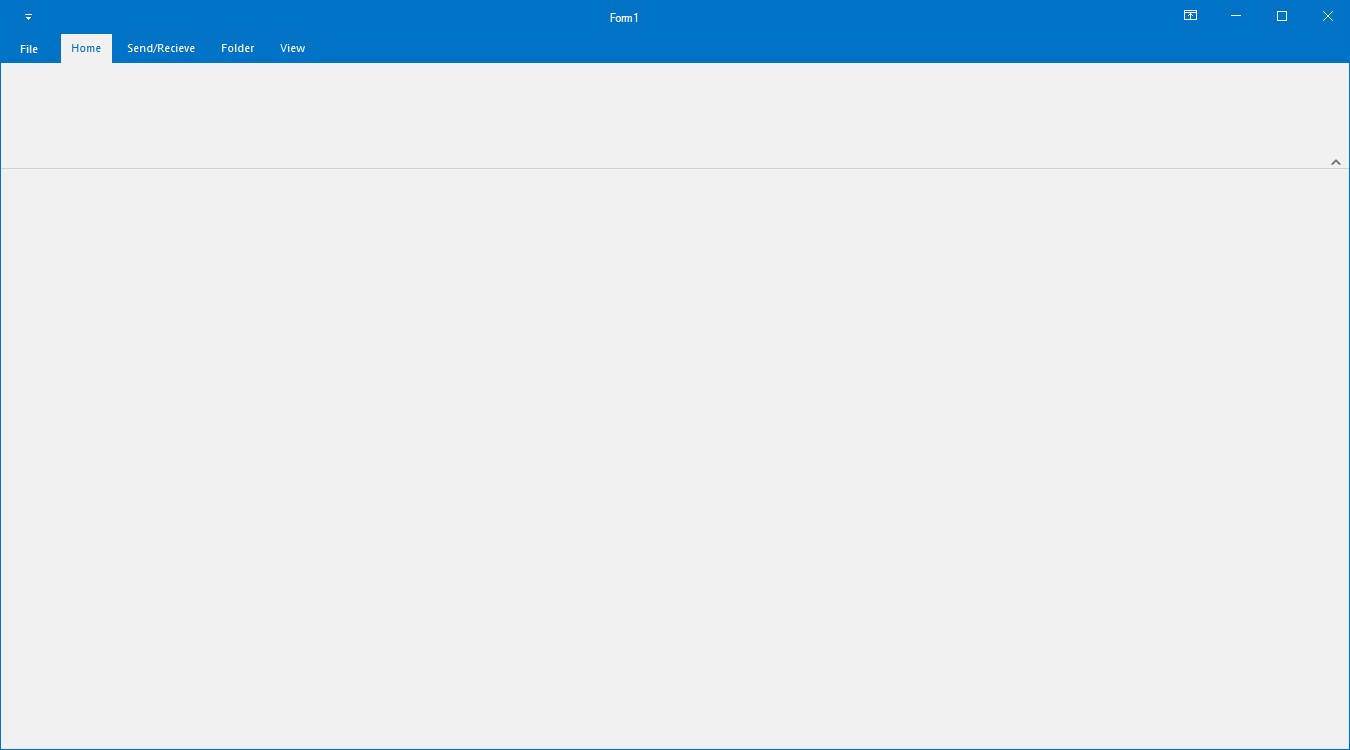
Adding groups inside Tab
ToolStripEx is used to create groups inside a Tab, it can be added to the Ribbon panel using its smart tag or using Add ToolStrip verb in the property grid.

private Syncfusion.Windows.Forms.Tools.ToolStripEx newToolStripEx;
private Syncfusion.Windows.Forms.Tools.ToolStripEx deleteToolStripEx;
private Syncfusion.Windows.Forms.Tools.ToolStripEx respondToolStripEx;
private Syncfusion.Windows.Forms.Tools.ToolStripEx moveToolStripEx;
private Syncfusion.Windows.Forms.Tools.ToolStripEx tagsToolStripEx;
private Syncfusion.Windows.Forms.Tools.ToolStripEx colorSchemeToolStripEx;
private Syncfusion.Windows.Forms.Tools.ToolStripEx quickstepsToolStripEx;
private Syncfusion.Windows.Forms.Tools.ToolStripEx currentViewToolStripEx;
private Syncfusion.Windows.Forms.Tools.ToolStripEx messagesToolStripEx;
private Syncfusion.Windows.Forms.Tools.ToolStripEx layoutToolStripEx;
private Syncfusion.Windows.Forms.Tools.ToolStripEx peopleToolStripEx;
private Syncfusion.Windows.Forms.Tools.ToolStripEx windowToolStripEx;
this.newToolStripEx = new ToolStripEx();
this.deleteToolStripEx = new ToolStripEx();
this.respondToolStripEx = new ToolStripEx();
this.moveToolStripEx = new ToolStripEx();
this.tagsToolStripEx = new ToolStripEx();
this.colorSchemeToolStripEx = new ToolStripEx();
this.quickstepsToolStripEx = new ToolStripEx();
this.currentViewToolStripEx = new ToolStripEx();
this.messagesToolStripEx = new ToolStripEx();
this.layoutToolStripEx = new ToolStripEx();
this.peopleToolStripEx = new ToolStripEx();
this.windowToolStripEx = new ToolStripEx();
this.newToolStripEx.Text = "New";
this.deleteToolStripEx.Text = "Delete";
this.respondToolStripEx.Text = "Respond";
this.moveToolStripEx.Text = "Move";
this.tagsToolStripEx.Text = "Tags";
this.colorSchemeToolStripEx.Text = "Color Scheme";
this.quickstepsToolStripEx.Text = "Quick Steps";
this.currentViewToolStripEx.Text = "Current View";
this.messagesToolStripEx.Text = "Messages";
this.layoutToolStripEx.Text = "Layout";
this.peopleToolStripEx.Text = "People";
this.windowToolStripEx.Text = "Window";
this.homeTabItem.Panel.Controls.AddRange(new Control[] { newToolStripEx, deleteToolStripEx, respondToolStripEx, moveToolStripEx, tagsToolStripEx, colorSchemeToolStripEx, quickstepsToolStripEx});
this.viewTabItem.Panel.Controls.AddRange(new Control[] { currentViewToolStripEx, messagesToolStripEx, layoutToolStripEx, peopleToolStripEx, windowToolStripEx });Private newToolStripEx As Syncfusion.Windows.Forms.Tools.ToolStripEx
Private deleteToolStripEx As Syncfusion.Windows.Forms.Tools.ToolStripEx
Private respondToolStripEx As Syncfusion.Windows.Forms.Tools.ToolStripEx
Private moveToolStripEx As Syncfusion.Windows.Forms.Tools.ToolStripEx
Private tagsToolStripEx As Syncfusion.Windows.Forms.Tools.ToolStripEx
Private colorSchemeToolStripEx As Syncfusion.Windows.Forms.Tools.ToolStripEx
Private quickstepsToolStripEx As Syncfusion.Windows.Forms.Tools.ToolStripEx
Private currentViewToolStripEx As Syncfusion.Windows.Forms.Tools.ToolStripEx
Private messagesToolStripEx As Syncfusion.Windows.Forms.Tools.ToolStripEx
Private layoutToolStripEx As Syncfusion.Windows.Forms.Tools.ToolStripEx
Private peopleToolStripEx As Syncfusion.Windows.Forms.Tools.ToolStripEx
Private windowToolStripEx As Syncfusion.Windows.Forms.Tools.ToolStripEx
Me.newToolStripEx = New ToolStripEx()
Me.deleteToolStripEx = New ToolStripEx()
Me.respondToolStripEx = New ToolStripEx()
Me.moveToolStripEx = New ToolStripEx()
Me.tagsToolStripEx = New ToolStripEx()
Me.colorSchemeToolStripEx = New ToolStripEx()
Me.quickstepsToolStripEx = New ToolStripEx()
Me.currentViewToolStripEx = New ToolStripEx()
Me.messagesToolStripEx = New ToolStripEx()
Me.layoutToolStripEx = New ToolStripEx()
Me.peopleToolStripEx = New ToolStripEx()
Me.windowToolStripEx = New ToolStripEx()
Me.newToolStripEx.Text = "New"
Me.deleteToolStripEx.Text = "Delete"
Me.respondToolStripEx.Text = "Respond"
Me.moveToolStripEx.Text = "Move"
Me.tagsToolStripEx.Text = "Tags"
Me.colorSchemeToolStripEx.Text = "Color Scheme"
Me.quickstepsToolStripEx.Text = "Quick Steps"
Me.currentViewToolStripEx.Text = "Current View"
Me.messagesToolStripEx.Text = "Messages"
Me.layoutToolStripEx.Text = "Layout"
Me.peopleToolStripEx.Text = "People"
Me.windowToolStripEx.Text = "Window"
Me.homeTabItem.Panel.Controls.AddRange(New Control() {newToolStripEx, deleteToolStripEx, respondToolStripEx, moveToolStripEx, tagsToolStripEx, colorSchemeToolStripEx, quickstepsToolStripEx})
Me.viewTabItem.Panel.Controls.AddRange(New Control() {currentViewToolStripEx, messagesToolStripEx, layoutToolStripEx, peopleToolStripEx, windowToolStripEx})To add controls to the ToolStripEx, click the button in it, as in the image below.

Add Button Controls
ToolStripButton
The Button is a control where the user can click to provide input to an application.
Adding ToolStripButton
For Adding ToolStripButton please refer Adding ToolStripDropDownButton and select Button from the Controls grid.
Through Coding
private System.Windows.Forms.ToolStripButton newMailButton;
private System.Windows.Forms.ToolStripButton IgnoreButton;
private System.Windows.Forms.ToolStripButton replyButton;
private System.Windows.Forms.ToolStripButton replyAllButton;
private System.Windows.Forms.ToolStripButton forwardButton;
this.newMailButton = new System.Windows.Forms.ToolStripButton();
this.IgnoreButton = new System.Windows.Forms.ToolStripButton();
this.replyButton = new System.Windows.Forms.ToolStripButton();
this.replyAllButton = new System.Windows.Forms.ToolStripButton();
this.forwardButton = new System.Windows.Forms.ToolStripButton();
this.newMailButton.Text = "New \r\nMail";
this.newMailButton.Image = Image.FromFile(@"Pictures\NewMail.png");
this.IgnoreButton.Text = "Ignore";
this.IgnoreButton.Image = Image.FromFile(@"Pictures\ignore.png");
this.replyButton.Text = "Reply";
this.replyButton.Image = Image.FromFile(@"Pictures\reply.png");
this.replyAllButton.Text = "Reply All";
this.replyAllButton.Image = Image.FromFile(@"Pictures\ReplyAll.png");
this.forwardButton.Text = "Forward";
this.forwardButton.Image = Image.FromFile(@"Pictures\forward.png");
this.newToolStripEx.Items.AddRange(new System.Windows.Forms.ToolStripItem[] {
this.newMailButton });
this.deleteToolStripEx.Items.AddRange(new System.Windows.Forms.ToolStripItem[] {
this.IgnoreButton });
this.respondToolStripEx.Items.AddRange(new System.Windows.Forms.ToolStripItem[] {
this.replyButton,
this.replyAllButton,
this.forwardButton});Private newMailButton As System.Windows.Forms.ToolStripButton
Private IgnoreButton As System.Windows.Forms.ToolStripButton
Private replyButton As System.Windows.Forms.ToolStripButton
Private replyAllButton As System.Windows.Forms.ToolStripButton
Private forwardButton As System.Windows.Forms.ToolStripButton
Me.newMailButton = New System.Windows.Forms.ToolStripButton()
Me.IgnoreButton = New System.Windows.Forms.ToolStripButton()
Me.replyButton = New System.Windows.Forms.ToolStripButton()
Me.replyAllButton = New System.Windows.Forms.ToolStripButton()
Me.forwardButton = New System.Windows.Forms.ToolStripButton()
Me.newMailButton.Text = "New " & vbCrLf & "Mail"
Me.newMailButton.Image = Image.FromFile("Pictures\NewMail.png")
Me.IgnoreButton.Text = "Ignore"
Me.IgnoreButton.Image = Image.FromFile("Pictures\ignore.png")
Me.replyButton.Text = "Reply"
Me.replyButton.Image = Image.FromFile("Pictures\reply.png")
Me.replyAllButton.Text = "Reply All"
Me.replyAllButton.Image = Image.FromFile("Pictures\ReplyAll.png")
Me.forwardButton.Text = "Forward"
Me.forwardButton.Image = Image.FromFile("Pictures\forward.png")
Me.newToolStripEx.Items.AddRange(New System.Windows.Forms.ToolStripItem() {Me.newMailButton})
Me.deleteToolStripEx.Items.AddRange(New System.Windows.Forms.ToolStripItem() {Me.IgnoreButton})
Me.respondToolStripEx.Items.AddRange(New System.Windows.Forms.ToolStripItem() {Me.replyButton, Me.replyAllButton, Me.forwardButton})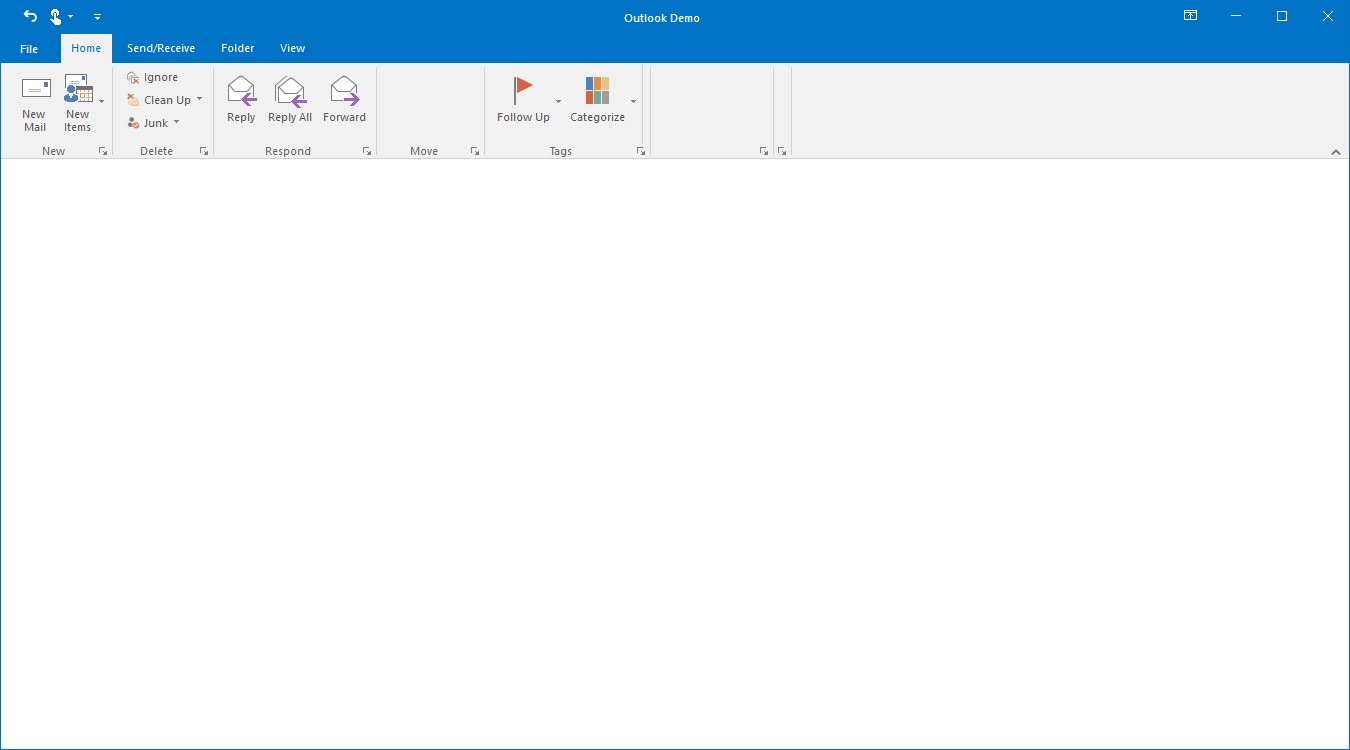
Adding ToolStripButton to simplified layout
When the simplified layout is enabled, the ToolStripButton can be added and displayed in a single line as shown below. To know more about the simplified layout, refer here.
ToolStripButton cutButton = new System.Windows.Forms.ToolStripButton();
cutButton.Text = "Cut";
toolStripEx1.Items.Add(cutButton);
ToolStripButton copyButton = new System.Windows.Forms.ToolStripButton();
copyButton.Text = "Copy";
toolStripEx1.Items.Add(copyButton);
ToolStripButton formatButton = new System.Windows.Forms.ToolStripButton();
formatButton.Text = "Format Painter";
toolStripEx1.Items.Add(formatButton);
// Add image for the items in simplified layout to image list.
ImageListAdv imageListAdv1 = new ImageListAdv(this.components);
imageListAdv1.Images.Add(Image.FromFile("..//..//Images/Medium Icons/Cut20.png"));
imageListAdv1.Images.Add(Image.FromFile("..//..//Images/Medium Icons/Copy20.png"));
imageListAdv1.Images.Add(Image.FromFile("..//..//Images/Medium Icons/FormatPainter20.png"));
ToolStripExImageProvider toolStripExImageProvider1 = new ToolStripExImageProvider(toolStripEx1);
// Setting image list to the MediumImageList for the toolStripEx1.
toolStripExImageProvider1.MediumImageList = imageListAdv1;
toolStripExImageProvider1.SetMediumItemImage(cutButton, 0);
toolStripExImageProvider1.SetMediumItemImage(copyButton, 1);
toolStripExImageProvider1.SetMediumItemImage(formatButton, 2);
Holding the Selection of ToolStripButton
For holding the selection of ToolstripButton after lost focus, use the property CheckOnClick, if true, the ToolStripButton will stay selected even after click and will go unselected after next click on that button, it simply acts as a toggling functionality to that button.
The default value is false.
this.newMailButton.CheckOnClick = true;Me.newMailButton.CheckOnClick = TrueToolStripRadioButton
ToolStripRadioButton control is used to select an option like normal RadioButton.
Adding ToolStripRadioButton
For Adding ToolStripRadioButton please refer Adding ToolStripDropDownButton and select RadioButton from the Controls grid.
Through Coding
Syncfusion.Windows.Forms.Tools.ToolStripRadioButton readRadioButton;
Syncfusion.Windows.Forms.Tools.ToolStripRadioButton unreadRadioButton;
Syncfusion.Windows.Forms.Tools.ToolStripPanelItem readUnreadPanel;
this.readRadioButton = new ToolStripRadioButton();
this.unreadRadioButton = new ToolStripRadioButton();
this.readUnreadPanel = new ToolStripPanelItem();
this.readRadioButton.Text = "Read";
this.unreadRadioButton.Text = "Unread";
this.readUnreadPanel.Items.AddRange(new ToolStripItem[] { readRadioButton, unreadRadioButton });
this.tagsToolStripEx.Items.AddRange(new ToolStripItem[] { readUnreadPanel });Dim readRadioButton As Syncfusion.Windows.Forms.Tools.ToolStripRadioButton
Dim unreadRadioButton As Syncfusion.Windows.Forms.Tools.ToolStripRadioButton
Dim readUnreadPanel As Syncfusion.Windows.Forms.Tools.ToolStripPanelItem
Me.readRadioButton = New ToolStripRadioButton()
Me.unreadRadioButton = New ToolStripRadioButton()
Me.readUnreadPanel = New ToolStripPanelItem()
Me.readRadioButton.Text = "Read"
Me.unreadRadioButton.Text = "Unread"
Me.readUnreadPanel.Items.AddRange(New ToolStripItem() {readRadioButton, unreadRadioButton})
Me.tagsToolStripEx.Items.AddRange(New ToolStripItem() {readUnreadPanel})
Adding ToolStripRadioButton to simplified layout
When the simplified layout is enabled, the ToolStripRadioButton can be added and displayed in a single line as shown below. To know more about the simplified layout, refer here.
ToolStripRadioButton radioButton = new ToolStripRadioButton();
radioButton.Text = "Custom System Button";
toolStripEx1.Items.Add(radioButton);
ToolStripDropDownButton
DropDownButton appears like normal button with an extra drop arrow. It accepts DropDownMenuItem as its children. When clicked, displays added menu items.
Adding ToolStripDropDownButton
Click the button inside the ToolStripEx panel and select DropDownButton from the controls grid.
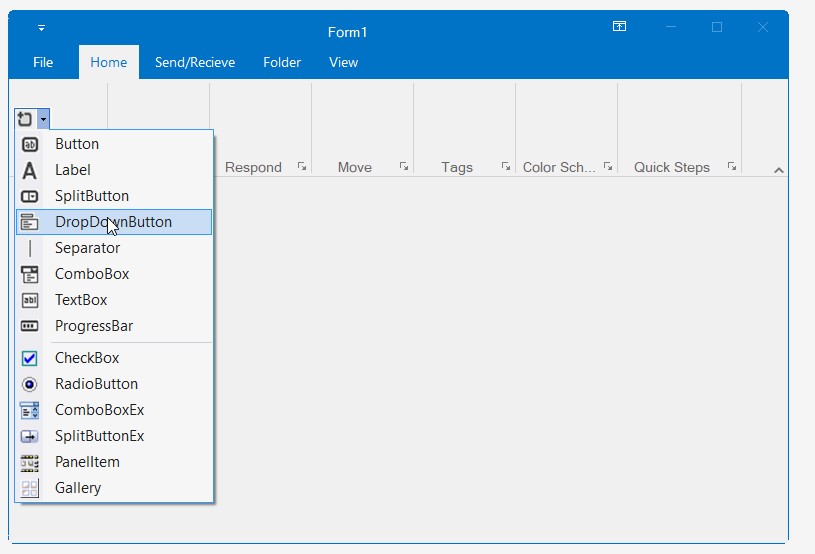
Through code
private System.Windows.Forms.ToolStripDropDownButton newItemsDropDownButton;
private System.Windows.Forms.ToolStripDropDownButton CleanUpDropDownButton;
private System.Windows.Forms.ToolStripDropDownButton JunkDropDownButton;
private System.Windows.Forms.ToolStripDropDownButton followUpDropDownButton;
private System.Windows.Forms.ToolStripDropDownButton categorizeDropDownButton;
this.newItemsDropDownButton = new System.Windows.Forms.ToolStripDropDownButton();
this.CleanUpDropDownButton = new System.Windows.Forms.ToolStripDropDownButton();
this.JunkDropDownButton = new System.Windows.Forms.ToolStripDropDownButton();
this.followUpDropDownButton = new System.Windows.Forms.ToolStripDropDownButton();
this.categorizeDropDownButton = new System.Windows.Forms.ToolStripDropDownButton();
this.newItemsDropDownButton.Text = "New Items";
this.CleanUpDropDownButton.Text = "Clean Up";
this.JunkDropDownButton.Text = "Junk";
this.followUpDropDownButton.Text = "Follow Up";
this.categorizeDropDownButton.Text = "Categorize";
this.newItemsDropDownButton.Image = Image.FromFile(@"Pictures\NewItems.png");
this.CleanUpDropDownButton.Image = Image.FromFile(@"Pictures\CleanUp.png");
this.JunkDropDownButton.Image = Image.FromFile(@"Pictures\junk.png");
this.followUpDropDownButton.Image = Image.FromFile(@"Pictures\FollowUp.png");
this.categorizeDropDownButton.Image = Image.FromFile(@"Pictures\categorize.png");
this.newToolStripEx.Items.Add(newItemsDropDownButton);
this.deleteToolStripEx.Items.AddRange(new System.Windows.Forms.ToolStripItem[] {
this.CleanUpDropDownButton, this.JunkDropDownButton});
this.tagsToolStripEx.Items.AddRange(new System.Windows.Forms.ToolStripItem[] {
this.followUpDropDownButton, this.categorizeDropDownButtonPrivate newItemsDropDownButton As System.Windows.Forms.ToolStripDropDownButton
Private CleanUpDropDownButton As System.Windows.Forms.ToolStripDropDownButton
Private JunkDropDownButton As System.Windows.Forms.ToolStripDropDownButton
Private followUpDropDownButton As System.Windows.Forms.ToolStripDropDownButton
Private categorizeDropDownButton As System.Windows.Forms.ToolStripDropDownButton
Me.newItemsDropDownButton = New System.Windows.Forms.ToolStripDropDownButton()
Me.CleanUpDropDownButton = New System.Windows.Forms.ToolStripDropDownButton()
Me.JunkDropDownButton = New System.Windows.Forms.ToolStripDropDownButton()
Me.followUpDropDownButton = New System.Windows.Forms.ToolStripDropDownButton()
Me.categorizeDropDownButton = New System.Windows.Forms.ToolStripDropDownButton()
Me.newItemsDropDownButton.Text = "New Items"
Me.CleanUpDropDownButton.Text = "Clean Up"
Me.JunkDropDownButton.Text = "Junk"
Me.followUpDropDownButton.Text = "Follow Up"
Me.categorizeDropDownButton.Text = "Categorize"
Me.newItemsDropDownButton.Image = Image.FromFile("Pictures\NewItems.png")
Me.CleanUpDropDownButton.Image = Image.FromFile("Pictures\CleanUp.png")
Me.JunkDropDownButton.Image = Image.FromFile("Pictures\junk.png")
Me.followUpDropDownButton.Image = Image.FromFile("Pictures\FollowUp.png")
Me.categorizeDropDownButton.Image = Image.FromFile("Pictures\categorize.png")
Me.newToolStripEx.Items.Add(newItemsDropDownButton)
Me.deleteToolStripEx.Items.AddRange(New System.Windows.Forms.ToolStripItem() {Me.CleanUpDropDownButton, Me.JunkDropDownButton})
Me.tagsToolStripEx.Items.AddRange(New System.Windows.Forms.ToolStripItem() {Me.followUpDropDownButton, Me.categorizeDropDownButton})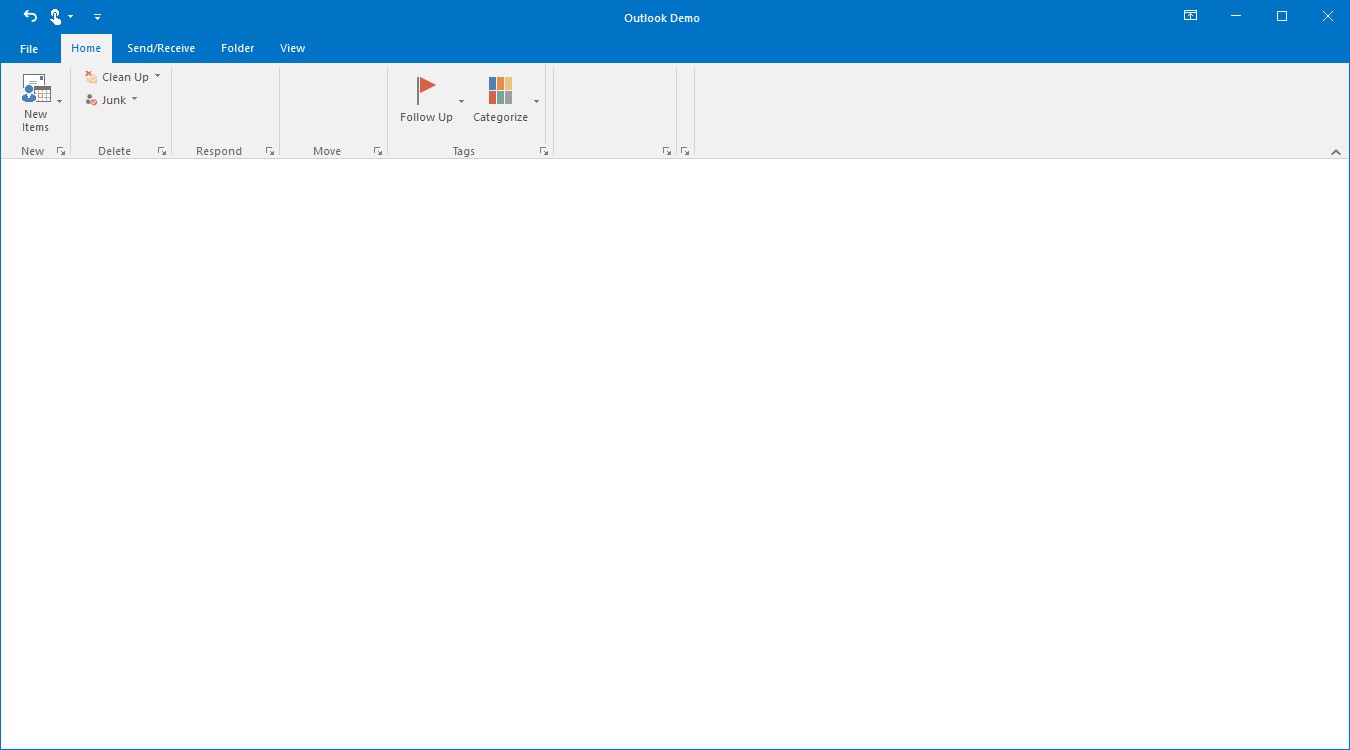
Adding ToolStripDropDownButton to simplified layout
When the simplified layout is enabled, the ToolStripDropDownButton can be added and displayed in a single line as shown below. To know more about the simplified layout, refer here.
ToolStripDropDownButton pasteButton = new System.Windows.Forms.ToolStripDropDownButton();
pasteButton.Text = "Paste";
toolStripEx1.Items.Add(pasteButton);
// Add image for the items in simplified layout to image list.
ImageListAdv imageListAdv1 = new ImageListAdv(this.components);
imageListAdv1.Images.Add(Image.FromFile("..//..//Images/Medium Icons/Paste20.png"));
ToolStripExImageProvider toolStripExImageProvider1 = new ToolStripExImageProvider(toolStripEx1);
// Setting image list to the MediumImageList for the toolStripEx1.
toolStripExImageProvider1.MediumImageList = imageListAdv1;
toolStripExImageProvider1.SetMediumItemImage(pasteButton, 0);
Adding DropDownMenuItems
DropDownMenuItems can be added through the button property DropDownItems, this will invoke an Item Collection editor and items can be added through this editor.
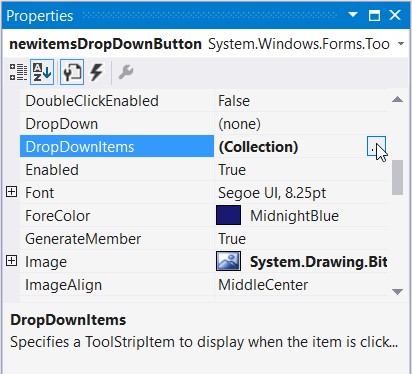
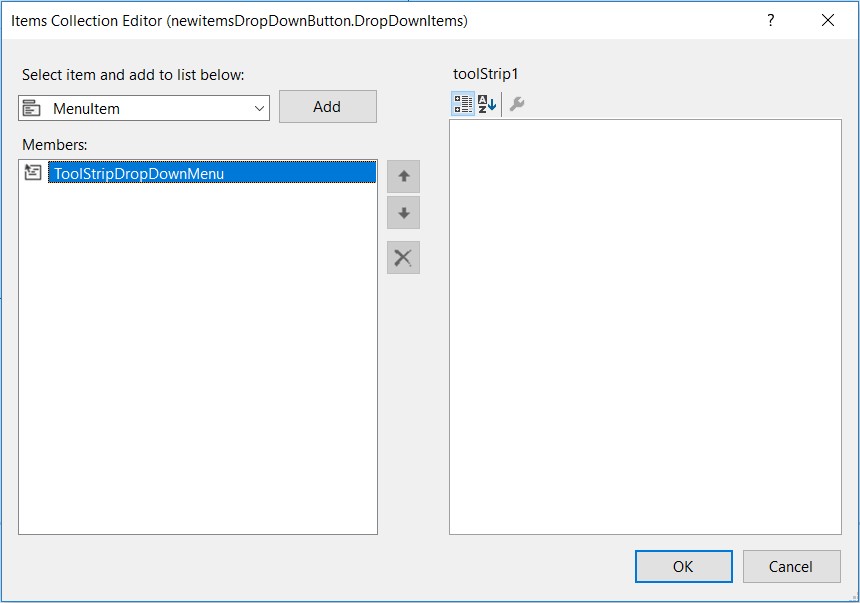
Items can also be added to the dropdown by clicking on the dropdown button and click the small arrow as shown in the image
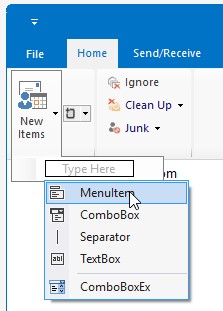
Through code
private System.Windows.Forms.ToolStripMenuItem emailMessageToolStripMenuItem;
private System.Windows.Forms.ToolStripMenuItem appointmentToolStripMenuItem;
private System.Windows.Forms.ToolStripMenuItem meetingToolStripMenuItem;
private System.Windows.Forms.ToolStripMenuItem contactToolStripMenuItem;
this.emailMessageToolStripMenuItem = new System.Windows.Forms.ToolStripMenuItem();
this.appointmentToolStripMenuItem = new System.Windows.Forms.ToolStripMenuItem();
this.meetingToolStripMenuItem = new System.Windows.Forms.ToolStripMenuItem();
this.contactToolStripMenuItem = new System.Windows.Forms.ToolStripMenuItem();
this.emailMessageToolStripMenuItem.Text = "E-mail Message";
this.appointmentToolStripMenuItem.Text = "Appointment";
this.meetingToolStripMenuItem.Text = "Meeting";
this.contactToolStripMenuItem.Text = "Contact";
this.newItemsDropDownButton.DropDownItems.AddRange(new System.Windows.Forms.ToolStripItem[] {
this.emailMessageToolStripMenuItem,
this.appointmentToolStripMenuItem,
this.meetingToolStripMenuItem,
this.contactToolStripMenuItem
});Private emailMessageToolStripMenuItem As System.Windows.Forms.ToolStripMenuItem
Private appointmentToolStripMenuItem As System.Windows.Forms.ToolStripMenuItem
Private meetingToolStripMenuItem As System.Windows.Forms.ToolStripMenuItem
Private contactToolStripMenuItem As System.Windows.Forms.ToolStripMenuItem
Me.emailMessageToolStripMenuItem = New System.Windows.Forms.ToolStripMenuItem()
Me.appointmentToolStripMenuItem = New System.Windows.Forms.ToolStripMenuItem()
Me.meetingToolStripMenuItem = New System.Windows.Forms.ToolStripMenuItem()
Me.contactToolStripMenuItem = New System.Windows.Forms.ToolStripMenuItem()
Me.emailMessageToolStripMenuItem.Text = "E-mail Message"
Me.appointmentToolStripMenuItem.Text = "Appointment"
Me.meetingToolStripMenuItem.Text = "Meeting"
Me.contactToolStripMenuItem.Text = "Contact"
Me.toolStripDropDownButton.DropDownItems.AddRange(New System.Windows.Forms.ToolStripItem() {Me.emailMessageToolStripMenuItem, Me.appointmentToolStripMenuItem,Me.meetingToolStripMenuItem, Me.contactToolStripMenuItem})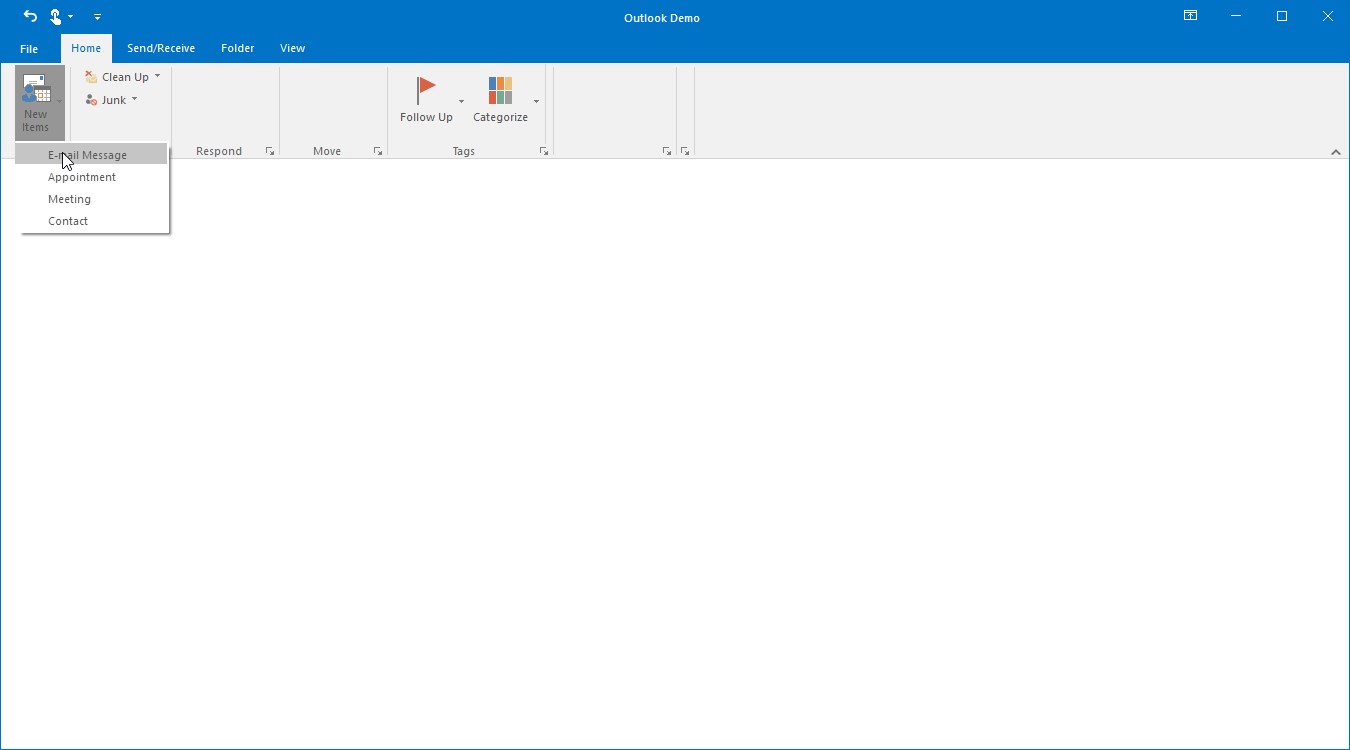
Properties of ToolStripDropDownButton
Foreground Settings
|
Property |
Description |
|---|---|
|
Text |
Gets or Sets the Text for the ToolStripDropDownButton. This text will be displayed, only if the DisplayStyle is Text or ImageAndText. |
|
Font |
Gets or Sets the font style for the display text. |
|
ForeColor |
Gets or Sets the fore color for the display text. |
|
TextAlign |
Gets or sets the alignment of the text in the item. The options are, TopLeft, TopCenter, TopRight, MiddleLeft, MiddleCenter, MiddleRight, BottomLeft, BottomCenter and BottomRight. |
|
TextDirection |
Gets or sets the direction of drawing the text. The direction are, Horizontal - Text is placed horizontally,Vertical90 - Text is placed vertically andVertical270 - Text is placed vertically at 270 degrees. |
|
TextImageRelation |
Gets or sets the relative location of the image to the text on the item. The options are, Overlay - Image and text shares the same space in the control,ImageAboveText - Image will be placed above the text,TextAboveImage - Text will be placed above the image,ImageBeforeText - Image will be placed before the text andTextBeforeImage - Text will be placed before the image. |
Image Settings
|
Property |
Description |
|---|---|
|
Image |
Gets or Sets the image for the item. |
|
ImageAlign |
Gets or sets the alignment of the image. The options are, TopLeft, TopCenter, TopRight, MiddleLeft, MiddleCenter, MiddleRight, BottomLeft, BottomCenter and BottomRight. |
|
ImageScaling |
Gets or Sets whether the image on the item will size to fit on the ToolStrip. |
|
ImageTransparentColor |
Gets or Sets the transparent color on the image, that supports transparency. |
Style Settings
|
Property |
Description |
|---|---|
|
DisplayStyle |
Gets or sets how the image and text are rendered. The styles are, Text - Displays only text,Image - Displays only image,ImageAndText - Displays image and text. |
|
Enabled |
Gets or sets whether the item is enabled. |
|
Visible |
Gets or sets whether the item is visible. |
|
Alignment |
Gets or sets the alignment of the item within the ToolStrip. They can be set to beginning (Left) or end (Right) of the ToolStripEx control. |
|
AutoSize |
Gets or sets whether the item should size itself based on its image and text. |
ToolTip Settings
|
Property |
Description |
|---|---|
|
AutoToolTip |
When set to true, will display the text set in the Text property as the item's tooltip. When set to false, will display the text set in the ToolTipText property. |
|
ToolTipText |
Gets or sets the text for the tooltip when AutoToolTip is set to false. |
RTL Support
|
Property |
Description |
|---|---|
|
RightToLeft |
Indicates whether the item should draw right to left for RTL languages. |
|
RightToLeftAutoMirrorImage |
Gets or sets whether image should mirror when RightToLeft is enabled for the item. |
DropDown settings
|
Property |
Description |
|---|---|
|
DropDown |
Gets or sets the ToolStripDropDown to be shown when the item is clicked. |
|
DropDownItems |
Invokes the Items Collection Editor and lets you add ToolStripItems to be displayed when the item is clicked. |
|
ShowDropDownArrow |
Gets or sets whether or not to show the drop down arrow on the ToolStripDropDown button. |
ToolStripSplitButtonEx
SplitButtonEx can perform like both normal Button as well as DropDownButton. It allows to click the button directly by clicking the upper part of the button and also it display list of items while click on the arrow.
Adding ToolStripSplitButtonEx
For Adding ToolStripSplitButtonEx please refer Adding ToolStripDropDownButton and select SplitButtonEx from the Controls grid.
private Syncfusion.Windows.Forms.Tools.ToolStripSplitButtonEx moveSplitButtonEx;
this.moveSplitButtonEx = new Syncfusion.Windows.Forms.Tools.ToolStripSplitButtonEx();
this.moveSplitButtonEx.Image = Image.FromFile(@"Pictures\move.png");
this.moveSplitButtonEx.Text = "Move";
this.moveToolStripEx.Items.AddRange(new System.Windows.Forms.ToolStripItem[] {
this.moveSplitButtonEx });Private moveSplitButtonEx As Syncfusion.Windows.Forms.Tools.ToolStripSplitButtonEx
Me.moveSplitButtonEx = New Syncfusion.Windows.Forms.Tools.ToolStripSplitButtonEx()
Me.moveSplitButtonEx.Image = Image.FromFile("Pictures\move.png")
Me.moveSplitButtonEx.Text = "Move"
Me.moveToolStripEx.Items.AddRange(New System.Windows.Forms.ToolStripItem() {Me.moveSplitButtonEx})Adding ToolStripSplitButtonEx to simplified layout
When the simplified layout is enabled, the ToolStripSplitButtonEx can be added and displayed in a single line as shown below. To know more about the simplified layout, refer here.
ToolStripSplitButtonEx pasteButton = new ToolStripSplitButtonEx();
pasteButton.Text = "Paste";
toolStripEx1.Items.Add(pasteButton);
// Add image for the items in simplified layout to image list.
ImageListAdv imageListAdv1 = new ImageListAdv(this.components);
imageListAdv1.Images.Add(Image.FromFile("..//..//Images/Medium Icons/Paste20.png"));
ToolStripExImageProvider toolStripExImageProvider1 = new ToolStripExImageProvider(toolStripEx1);
// Setting image list to the MediumImageList for the toolStripEx1.
toolStripExImageProvider1.MediumImageList = imageListAdv1;
toolStripExImageProvider1.SetMediumItemImage(pasteButton, 0);
ToolStripSplitButton
The properties of SplitButton is like SplitButtonEx except DropDownButtonWidth property is available for SplitButton control.
private System.Windows.Forms.ToolStripSplitButton rulesSplitButton;
this.rulesSplitButton = new System.Windows.Forms.ToolStripSplitButton();
this.rulesSplitButton.Image = Image.FromFile(@"Pictures\rules.png");
this.rulesSplitButton.Text = "Rules";
this.rulesSplitButton.DropDownButtonWidth = 20;
this.moveToolStripEx.Items.AddRange(new System.Windows.Forms.ToolStripItem[] {
this.rulesSplitButton });Private rulesSplitButton As System.Windows.Forms.ToolStripSplitButton
Me.rulesSplitButton = New System.Windows.Forms.ToolStripSplitButton()
Me.rulesSplitButton.Image = Image.FromFile("Pictures\rules.png")
Me.rulesSplitButton.Text = "Rules"
Me.rulesSplitButton.DropDownButtonWidth = 20
Me.moveToolStripEx.Items.AddRange(New System.Windows.Forms.ToolStripItem() {Me.rulesSplitButton})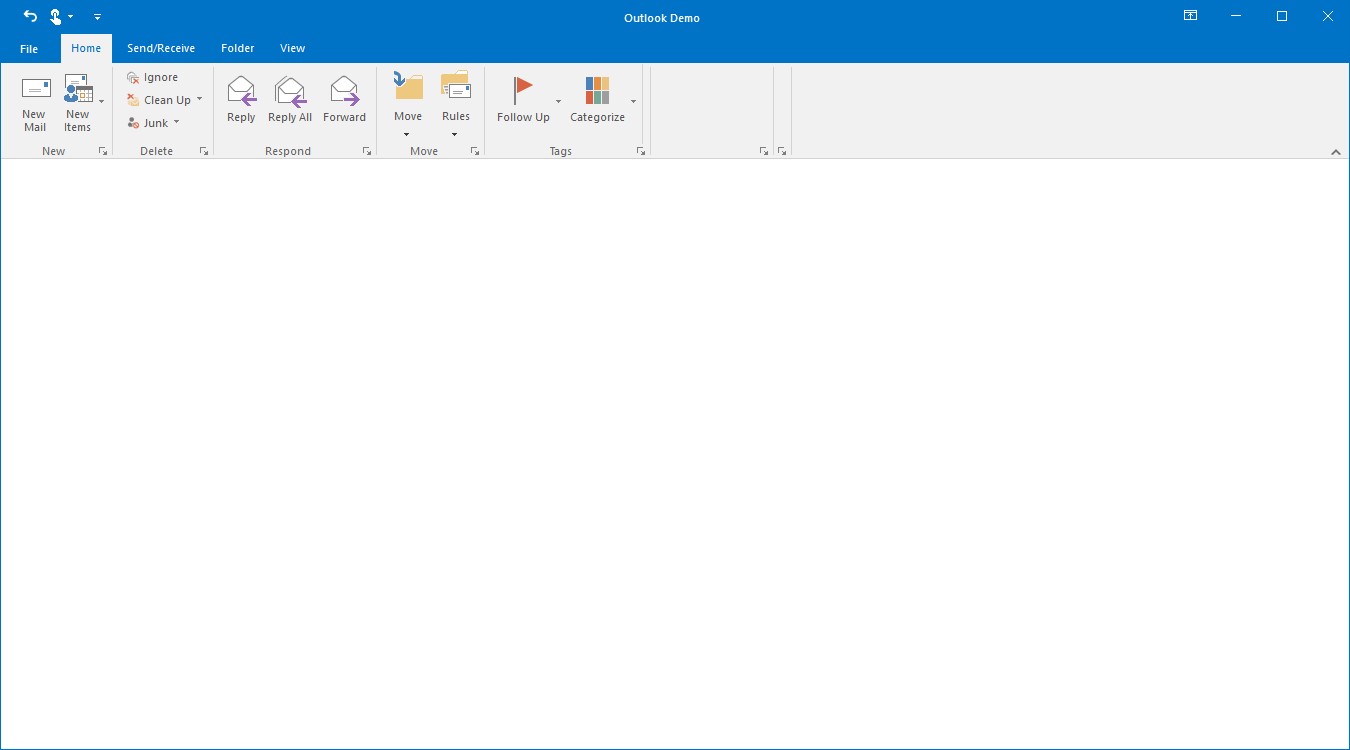
Adding ToolStripSplitButton to simplified layout
When the simplified layout is enabled, the ToolStripSplitButton can be added and displayed in a single line as shown below. To know more about the simplified layout, refer here.
ToolStripSplitButton pasteButton = new ToolStripSplitButton();
pasteButton.Text = "Paste";
toolStripEx1.Items.Add(pasteButton);
// Add image for the items in simplified layout to image list.
ImageListAdv imageListAdv1 = new ImageListAdv(this.components);
imageListAdv1.Images.Add(Image.FromFile("..//..//Images/Medium Icons/Paste20.png"));
ToolStripExImageProvider toolStripExImageProvider1 = new ToolStripExImageProvider(toolStripEx1);
// Setting image list to the MediumImageList for the toolStripEx1.
toolStripExImageProvider1.MediumImageList = imageListAdv1;
toolStripExImageProvider1.SetMediumItemImage(pasteButton, 0);
Text alignment for DropDownMenuItems and SplitButtonMenuItems
Text alignment for the “ToolStripMenuItem” can be set using its TextAlign property. To enable this alignment, AllowMenuTextAlignment of its parent “ToolStripEx” must be set “True” mandatorily. The various options of TextAlign are listed below.
- TopLeft
- TopCenter
- TopRight
- MiddleLeft
- MiddleCenter
- MiddleRight
- BottomLeft
- BottomCenter
- BottomRight
clipboardToolstrip.AllowMenuTextAlignment = true;
pasteSpecialToolStripMenuItem.TextAlign = ContentAlignment.MiddleRight;
setAsToolStripMenuItem.TextAlign = ContentAlignment.MiddleRight;
setDefaultPasteToolStripMenuItem.TextAlign = ContentAlignment.MiddleRight;clipboardToolstrip.AllowMenuTextAlignment = True
pasteSpecialToolStripMenuItem.TextAlign = ContentAlignment.MiddleRight
setAsToolStripMenuItem.TextAlign = ContentAlignment.MiddleRight
setDefaultPasteToolStripMenuItem.TextAlign = ContentAlignment.MiddleRight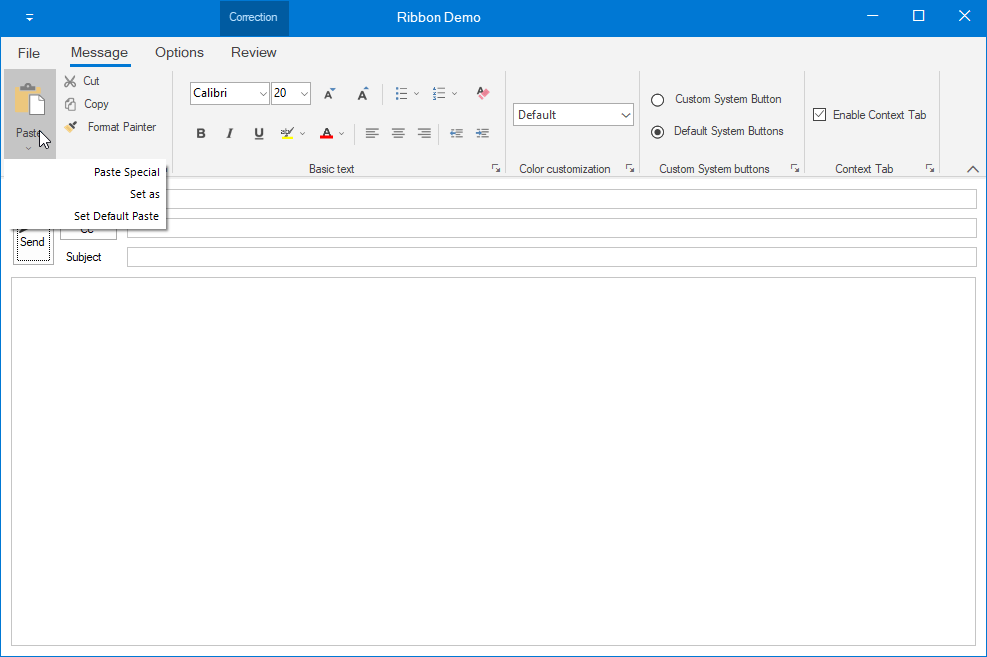
Add ToolStripComboBoxEx
ToolStripComboBox control is used to display the list of items, as ComboBox. It can be added to a ToolStripEx directly or through the panel.
Adding control manually
private Syncfusion.Windows.Forms.Tools.ToolStripComboBoxEx visualstyleComboBox;
private Syncfusion.Windows.Forms.Tools.ToolStripComboBoxEx schemeComboBox;
this.visualstyleComboBox = new ToolStripComboBoxEx();
this.schemeComboBox = new ToolStripComboBoxEx();
this.visualstyleComboBox.Items.AddRange(new object[] {
"Office 2016 Style",
"Office 2013 Style",
"Touch Style",
"Office 2010 Style",
"Office 2007 Style"});
this.colorSchemeToolStripEx.Items.AddRange(new ToolStripItem[] { visualstyleComboBox, schemeComboBox });Private visualstyleComboBox As Syncfusion.Windows.Forms.Tools.ToolStripComboBoxEx
Private schemeComboBox As Syncfusion.Windows.Forms.Tools.ToolStripComboBoxEx
Me.visualstyleComboBox = New ToolStripComboBoxEx()
Me.schemeComboBox = New ToolStripComboBoxEx()
Me.visualstyleComboBox.Items.AddRange(New Object() {"Office 2016 Style", "Office 2013 Style", "Touch Style", "Office 2010 Style", "Office 2007 Style"})
Me.colorSchemeToolStripEx.Items.AddRange(New ToolStripItem() {visualstyleComboBox, schemeComboBox})
DropDownStyle
- Simple – There will be no dropdown button, all the items will be shown below the control.
- DropDown – Contains a dropdown button and the text in ToolStripComboBoxEx can be edited.
- DropDownList – Contains a dropdown button and restricts the editing of text in ToolStripComboBoxEx
Adding ToolStripComboBoxEx to simplified layout
When the simplified layout is enabled, the ToolStripComboBoxEx can be added and displayed in a single line as shown below. To know more about the simplified layout, refer here.
ToolStripComboBoxEx comboBoxEx = new ToolStripComboBoxEx();
comboBoxEx.Items.AddRange(new object[] { "Office 2019 Style", "Office 2016 Style",
"Touch Style", "Office 2013 Style", "Office 2010 Style"});
toolStripEx1.Items.Add(comboBoxEx);
ToolStripComboBox
ToolStripComboBox is similar to ToolStripComboBoxEx with some changes in visual styles.
Add ToolStripGallery
RibbonControlAdv provides options to add a collection of items and store them into a gallery. A gallery can be added to a ToolStripTabItem using Panel Button.
Gallery Items can be added through the Items Collection Editor from the Property grid of ToolStripGallery.
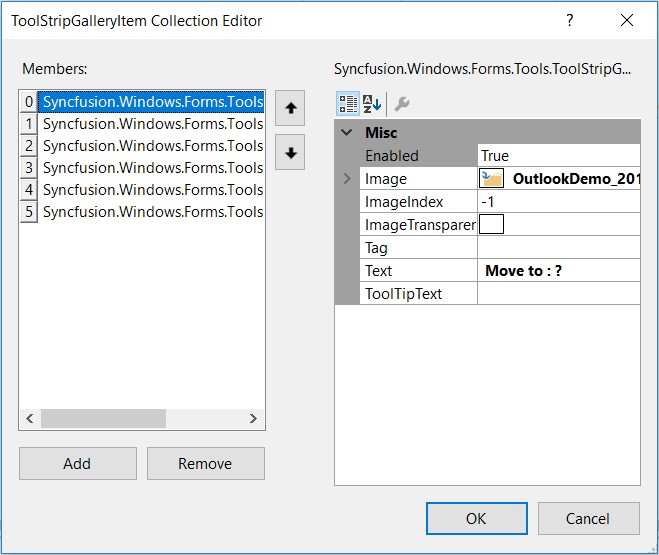
Scroller Settings
Sets the Scroller for the Gallery, there are two types of scrollers
- Standard Scroller – A normal scroller which scrolls up and down.
- Compact Scroller – A Special scroller which has Up and Down arrow and contains another down arrow which opens all the items in the gallery.
//Adding new ToolStripGallery control
private Syncfusion.Windows.Forms.Tools.ToolStripGallery quickGallery;
//Creating an instance of the control
this.quickGallery = new Syncfusion.Windows.Forms.Tools.ToolStripGallery();
//gallery items
Syncfusion.Windows.Forms.Tools.ToolStripGalleryItem movetoGalleryItem = new Syncfusion.Windows.Forms.Tools.ToolStripGalleryItem();
Syncfusion.Windows.Forms.Tools.ToolStripGalleryItem toManagerGalleryItem = new Syncfusion.Windows.Forms.Tools.ToolStripGalleryItem();
Syncfusion.Windows.Forms.Tools.ToolStripGalleryItem teamEmailGalleryItem = new Syncfusion.Windows.Forms.Tools.ToolStripGalleryItem();
Syncfusion.Windows.Forms.Tools.ToolStripGalleryItem replyAndDeleteGalleryItem = new Syncfusion.Windows.Forms.Tools.ToolStripGalleryItem();
Syncfusion.Windows.Forms.Tools.ToolStripGalleryItem doneGalleryItem = new Syncfusion.Windows.Forms.Tools.ToolStripGalleryItem();
Syncfusion.Windows.Forms.Tools.ToolStripGalleryItem createNewGalleryItem = new Syncfusion.Windows.Forms.Tools.ToolStripGalleryItem();
movetoGalleryItem.Image = Image.FromFile(@"Pictures\moveto.png");
movetoGalleryItem.Text = " Move to : ?";
toManagerGalleryItem.Image = Image.FromFile(@"Pictures\ToManager.png");
toManagerGalleryItem.Text = "To Manager";
teamEmailGalleryItem.Image = Image.FromFile(@"Pictures\TeamEmail.png");
teamEmailGalleryItem.Text = "Team Email";
replyAndDeleteGalleryItem.Image = Image.FromFile(@"Pictures\ReplyAndDelete.png");
replyAndDeleteGalleryItem.Text = "Reply and Delete";
doneGalleryItem.Image = Image.FromFile(@"Pictures\done.png");
doneGalleryItem.Text = "Done";
createNewGalleryItem.Image = Image.FromFile(@"Pictures\CreateNew.png");
createNewGalleryItem.Text = " Create New";
//Adding items to the gallery
this.quickGallery.Items.Add(movetoGalleryItem);
this.quickGallery.Items.Add(toManagerGalleryItem);
this.quickGallery.Items.Add(teamEmailGalleryItem);
this.quickGallery.Items.Add(replyAndDeleteGalleryItem);
this.quickGallery.Items.Add(doneGalleryItem);
this.quickGallery.Items.Add(createNewGalleryItem);
//Adding Gallery to ToolStripEx
this.quickstepsToolStripEx.Items.AddRange(new System.Windows.Forms.ToolStripItem[] {
this.quickGallery});Private quickGallery As Syncfusion.Windows.Forms.Tools.ToolStripGallery
Me.quickGallery = New Syncfusion.Windows.Forms.Tools.ToolStripGallery()
Dim movetoGalleryItem As Syncfusion.Windows.Forms.Tools.ToolStripGalleryItem = New Syncfusion.Windows.Forms.Tools.ToolStripGalleryItem()
Dim toManagerGalleryItem As Syncfusion.Windows.Forms.Tools.ToolStripGalleryItem = New Syncfusion.Windows.Forms.Tools.ToolStripGalleryItem()
Dim teamEmailGalleryItem As Syncfusion.Windows.Forms.Tools.ToolStripGalleryItem = New Syncfusion.Windows.Forms.Tools.ToolStripGalleryItem()
Dim replyAndDeleteGalleryItem As Syncfusion.Windows.Forms.Tools.ToolStripGalleryItem = New Syncfusion.Windows.Forms.Tools.ToolStripGalleryItem()
Dim doneGalleryItem As Syncfusion.Windows.Forms.Tools.ToolStripGalleryItem = New Syncfusion.Windows.Forms.Tools.ToolStripGalleryItem()
Dim createNewGalleryItem As Syncfusion.Windows.Forms.Tools.ToolStripGalleryItem = New Syncfusion.Windows.Forms.Tools.ToolStripGalleryItem()
movetoGalleryItem.Image = Image.FromFile("Pictures\moveto.png")
movetoGalleryItem.Text = " Move to : ?"
toManagerGalleryItem.Image = Image.FromFile("Pictures\ToManager.png")
toManagerGalleryItem.Text = "To Manager"
teamEmailGalleryItem.Image = Image.FromFile("Pictures\TeamEmail.png")
teamEmailGalleryItem.Text = "Team Email"
replyAndDeleteGalleryItem.Image = Image.FromFile("Pictures\ReplyAndDelete.png")
replyAndDeleteGalleryItem.Text = "Reply and Delete"
doneGalleryItem.Image = Image.FromFile("Pictures\done.png")
doneGalleryItem.Text = "Done"
createNewGalleryItem.Image = Image.FromFile("Pictures\CreateNew.png")
createNewGalleryItem.Text = " Create New"
Me.quickGallery.Items.Add(movetoGalleryItem)
Me.quickGallery.Items.Add(toManagerGalleryItem)
Me.quickGallery.Items.Add(teamEmailGalleryItem)
Me.quickGallery.Items.Add(replyAndDeleteGalleryItem)
Me.quickGallery.Items.Add(doneGalleryItem)
Me.quickGallery.Items.Add(createNewGalleryItem)
Me.quickstepsToolStripEx.Items.AddRange(New System.Windows.Forms.ToolStripItem() {Me.quickGallery})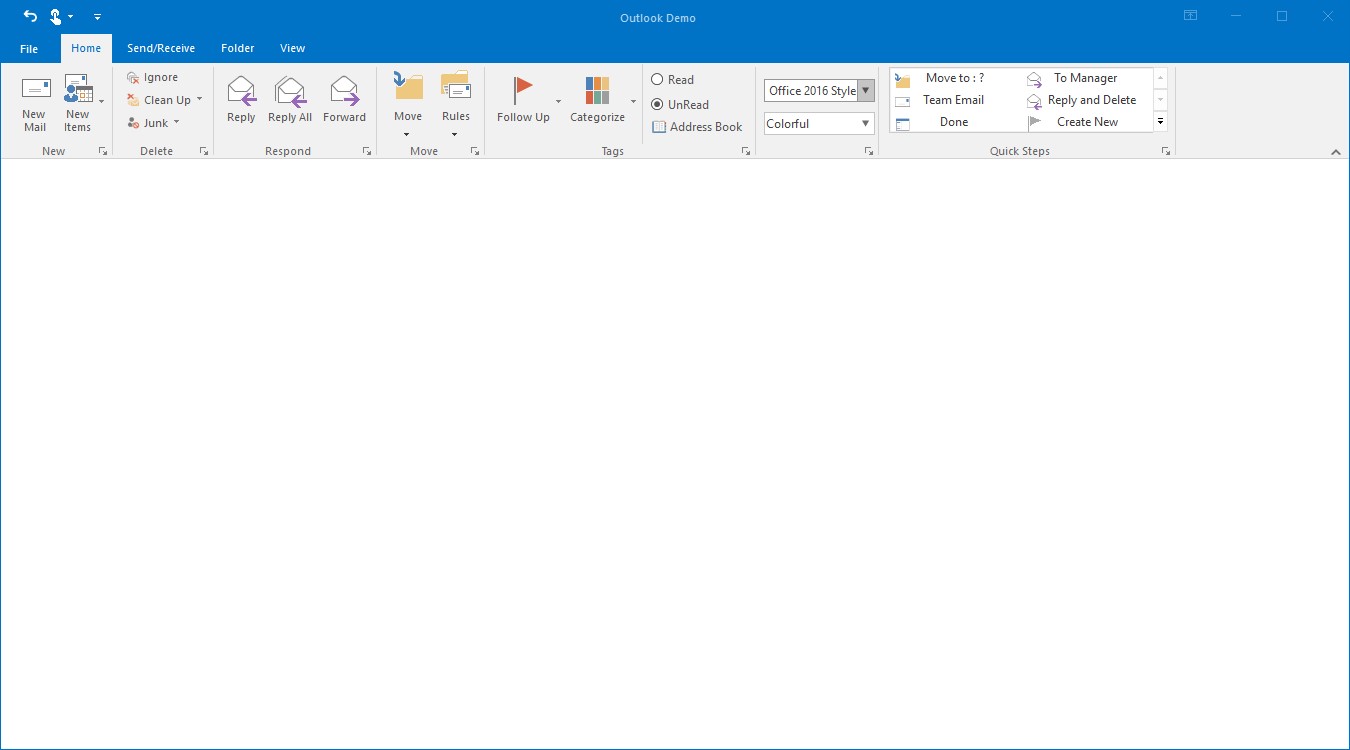
Adding ToolStripGallery to simplified layout
When the simplified layout is enabled, the ToolStripGallery can be added and displayed in a single line as shown below. To know more about the simplified layout, refer here.
//Creating an instance of the control
this.quickGallery = new Syncfusion.Windows.Forms.Tools.ToolStripGallery();
Syncfusion.Windows.Forms.Tools.ToolStripGalleryItem movetoGalleryItem = new Syncfusion.Windows.Forms.Tools.ToolStripGalleryItem();
Syncfusion.Windows.Forms.Tools.ToolStripGalleryItem toManagerGalleryItem = new Syncfusion.Windows.Forms.Tools.ToolStripGalleryItem();
Syncfusion.Windows.Forms.Tools.ToolStripGalleryItem teamEmailGalleryItem = new Syncfusion.Windows.Forms.Tools.ToolStripGalleryItem();
Syncfusion.Windows.Forms.Tools.ToolStripGalleryItem replyAndDeleteGalleryItem = new Syncfusion.Windows.Forms.Tools.ToolStripGalleryItem();
movetoGalleryItem.Text = " Move to : ?";
toManagerGalleryItem.Text = "To Manager";
teamEmailGalleryItem.Text = "Team Email";
replyAndDeleteGalleryItem.Text = "Reply and Delete";
//Adding items to the gallery
this.quickGallery.Items.Add(movetoGalleryItem);
this.quickGallery.Items.Add(toManagerGalleryItem);
this.quickGallery.Items.Add(teamEmailGalleryItem);
this.quickGallery.Items.Add(replyAndDeleteGalleryItem);
toolStripEx1.Items.Add(quickGallery);
Add ToolStripCheckBox
ToolStripCheckBox is used to select or unselect options. It provides similar set of functionalities like normal CheckBox control in Ribbon.It can be added to a ToolStripEx directly or through a panel.
//Adding new ToolStripCheckBox
private Syncfusion.Windows.Forms.Tools.ToolStripCheckBox showAsConversationCheckBox;
//Creating an instance of the control
this.showAsConversationCheckBox = new Syncfusion.Windows.Forms.Tools.ToolStripCheckBox();
this.showAsConversationCheckBox.Text = "Show As Conversation";
//Adding control to the ToolStripEx
this.messagesToolStripEx.Items.Add(showAsConversationCheckBox);Private showAsConversationCheckBox As Syncfusion.Windows.Forms.Tools.ToolStripCheckBox
Me.showAsConversationCheckBox = New Syncfusion.Windows.Forms.Tools.ToolStripCheckBox()
Me.showAsConversationCheckBox.Text = "Show As Conversation"
Me.messagesToolStripEx.Items.Add(showAsConversationCheckBox)
Adding ToolStripCheckBox to simplified layout
When the simplified layout is enabled, the ToolStripCheckBox can be added and displayed in a single line as shown below. To know more about the simplified layout, refer here.
ToolStripCheckBox checkBox = new ToolStripCheckBox();
checkBox.Text = "Enable Context Tab";
toolStripEx1.Items.Add(checkBox);
Add ToolStripTextBox
Ribbon TextBox control provide similar set of functionalities like normal TextBox control in Ribbon Instance. It can be added to a ToolStripEx directly or through a panel.
//Adding new ToolStripTextBox
private System.Windows.Forms.ToolStripTextBox applicationNameTextBox;
private Syncfusion.Windows.Forms.Tools.ToolStripPanelItem applicationPanelItem;
this.applicationNameTextBox = new System.Windows.Forms.ToolStripTextBox();
this.applicationPanelItem = new Syncfusion.Windows.Forms.Tools.ToolStripPanelItem();
this.applicationNameTextBox.Text = "Outlook";
this.applicationNameTextBox.ForeColor = System.Drawing.SystemColors.HotTrack;
this.applicationPanelItem.Items.AddRange(new System.Windows.Forms.ToolStripItem[] {
this.applicationNameTextBox});
this.peopleToolStripEx.Items.AddRange(new System.Windows.Forms.ToolStripItem[] {
this.applicationPanelItem});Private applicationNameTextBox As System.Windows.Forms.ToolStripTextBox
Private applicationPanelItem As Syncfusion.Windows.Forms.Tools.ToolStripPanelItem
Me.applicationNameTextBox = New System.Windows.Forms.ToolStripTextBox()
Me.applicationPanelItem = New Syncfusion.Windows.Forms.Tools.ToolStripPanelItem()
Me.applicationNameTextBox.Text = "Outlook"
Me.applicationNameTextBox.ForeColor = System.Drawing.SystemColors.HotTrack
Me.applicationPanelItem.Items.AddRange(New System.Windows.Forms.ToolStripItem() {Me.applicationNameTextBox})
Me.peopleToolStripEx.Items.AddRange(New System.Windows.Forms.ToolStripItem() {Me.applicationPanelItem})In the code, the text box will be added to a panel and the panel will be added to the ToolStripEx. (For more details about panel refer Arrange items using ToolStripPanelItem)

Adding ToolStripTextBox to simplified layout
When the simplified layout is enabled, the ToolStripTextBox can be added and displayed in a single line as shown below. To know more about the simplified layout, refer here.
ToolStripTextBox textBox = new ToolStripTextBox();
textBox.Text = "Enter Text";
toolStripEx1.Items.Add(textBox);
Add ToolStripProgressBar
ToolStripProgressBar can be used to provide a visual cue that the application is indeed working and the task is being completed item. It can be added to a ToolStripEx directly or through a panel.
//Adding new ToolStripProgressBar
private System.Windows.Forms.ToolStripProgressBar loadingProgressBar;
private Syncfusion.Windows.Forms.Tools.ToolStripPanelItem progressbarPanelItem;
//Creating new instance of the control
this.loadingProgressBar = new System.Windows.Forms.ToolStripProgressBar();
this.progressbarPanelItem = new Syncfusion.Windows.Forms.Tools.ToolStripPanelItem();
this.loadingProgressBar.Value = 50;
this.progressbarPanelItem.Items.AddRange(new System.Windows.Forms.ToolStripItem[] {
this.loadingProgressBar});
this.layoutToolStripEx.Items.AddRange(new System.Windows.Forms.ToolStripItem[] {
this.progressbarPanelItem});Private loadingProgressBar As System.Windows.Forms.ToolStripProgressBar
Private progressbarPanelItem As Syncfusion.Windows.Forms.Tools.ToolStripPanelItem
Me.loadingProgressBar = New System.Windows.Forms.ToolStripProgressBar()
Me.progressbarPanelItem = New Syncfusion.Windows.Forms.Tools.ToolStripPanelItem()
Me.loadingProgressBar.Value = 50
Me.progressbarPanelItem.Items.AddRange(New System.Windows.Forms.ToolStripItem() {Me.loadingProgressBar})
Me.layoutToolStripEx.Items.AddRange(New System.Windows.Forms.ToolStripItem() {Me.progressbarPanelItem})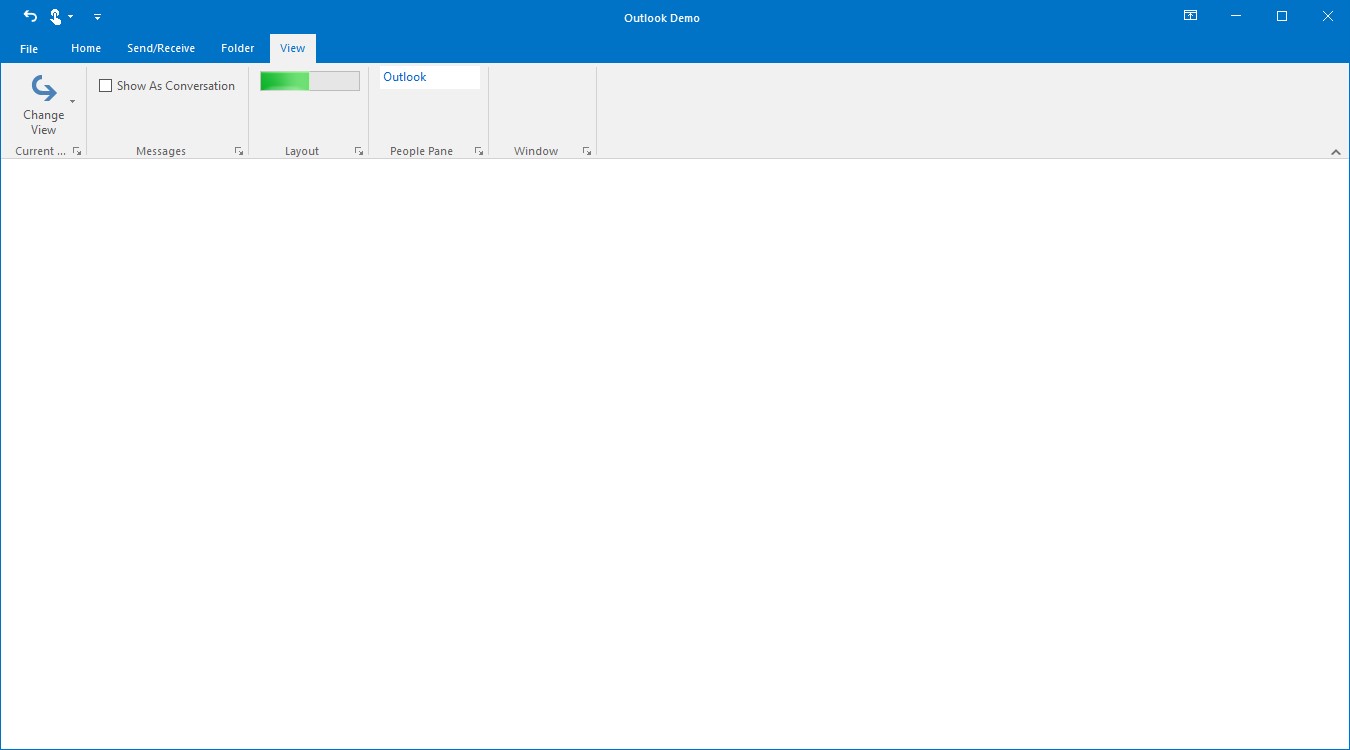
Adding ToolStripProgressBar to simplified layout
When the simplified layout is enabled, the ToolStripProgressBar can be added and displayed in a single line as shown below. To know more about the simplified layout, refer here.
ToolStripProgressBar progressBar = new ToolStripProgressBar();
progressBar.Value = 50;
toolStripEx1.Items.Add(progressBar);
Add ToolStripLabel
ToolStripLabel can be added to a ToolStripEx directly or through a panel.
//Adding new ToolStripLabel
private System.Windows.Forms.ToolStripLabel applicationNameLabel;
private System.Windows.Forms.ToolStripLabel loadingToolStripLabel;
this.applicationNameLabel = new System.Windows.Forms.ToolStripLabel();
this.applicationNameLabel.Text = "Application Name";
this.loadingToolStripLabel = new System.Windows.Forms.ToolStripLabel();
this.loadingToolStripLabel.Text = "Loading Attachments";
this.applicationPanelItem.Items.Add(applicationNameLabel);
this.progressbarPanelItem.Items.Add(this.loadingToolStripLabel);Private applicationNameLabel As System.Windows.Forms.ToolStripLabel
Private loadingToolStripLabel As System.Windows.Forms.ToolStripLabel
Me.applicationNameLabel = New System.Windows.Forms.ToolStripLabel()
Me.applicationNameLabel.Text = "Application Name"
Me.loadingToolStripLabel = New System.Windows.Forms.ToolStripLabel()
Me.loadingToolStripLabel.Text = "Loading Attachments"
Me.applicationPanelItem.Items.Add(applicationNameLabel)
Me.progressbarPanelItem.Items.Add(Me.loadingToolStripLabel)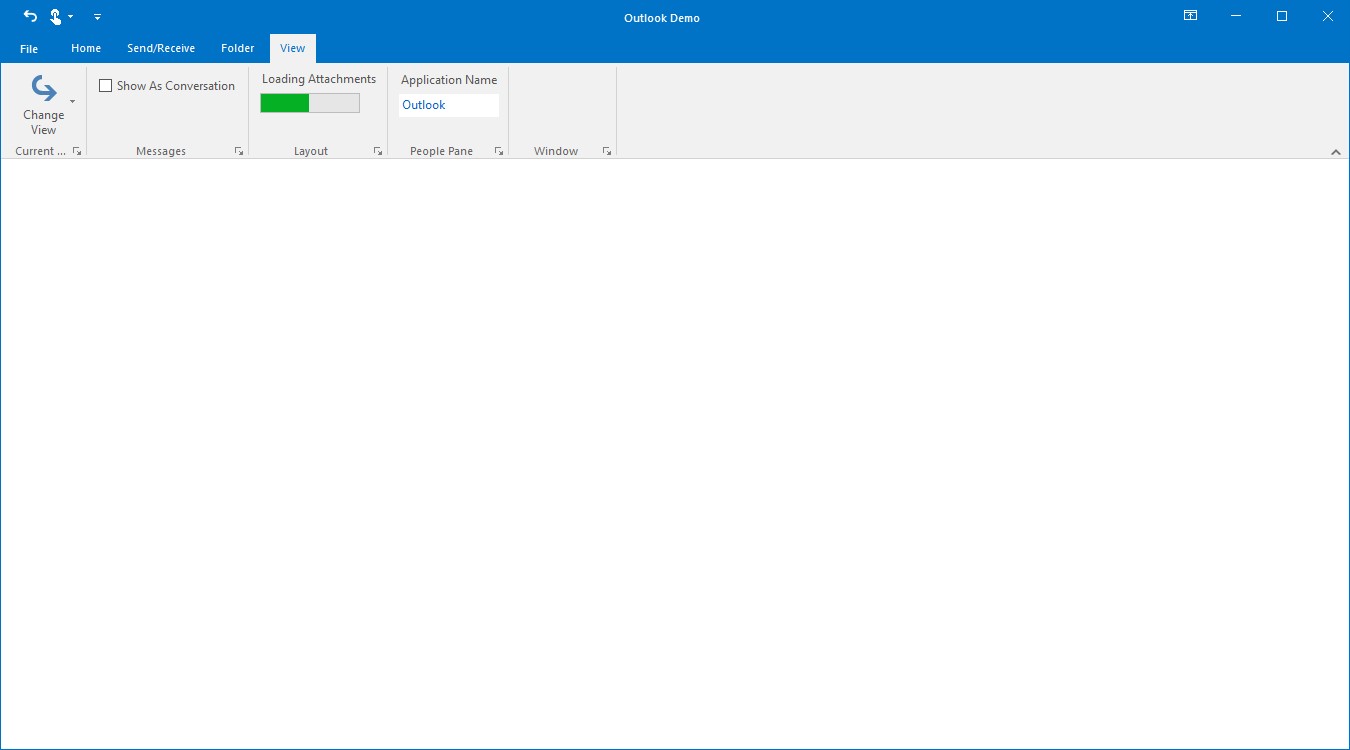
Adding ToolStripLabel to simplified layout
When the simplified layout is enabled, the ToolStripLabel can be added and displayed in a single line as shown below. To know more about the simplified layout, refer here.
ToolStripLabel toolStripLabel = new ToolStripLabel();
toolStripLabel.Text = "Loading Attachments";
toolStripEx1.Items.Add(toolStripLabel);
Add ToolStripSeparator
Ribbon Separator is used to separate the similar set of Ribbon elements in Ribbon. It can separate RibbonButtons according to their purpose and it can be added to a ToolStripEx directly or through a panel.
//Adding new toolStripSeparator
private System.Windows.Forms.toolStripSeparator toolStripSeparator;
//Creating new instance of the control
this.toolStripSeparator = new toolStripSeparator();
//Adding the control to the ToolStripEx
this.tagsToolStripEx.Items.Add(toolStripSeparator);Private toolStripSeparator As System.Windows.Forms.toolStripSeparator
Me.toolStripSeparator = New toolStripSeparator()
Me.tagsToolStripEx.Items.Add(toolStripSeparator)
Adding ToolStripSeparator to simplified layout
When the simplified layout is enabled, the ToolStripSeparator can be added and displayed in a single line as shown below. To know more about the simplified layout, refer here.
ToolStripButton cutButton = new System.Windows.Forms.ToolStripButton();
cutButton.Text = "Cut";
toolStripEx1.Items.Add(cutButton);
ToolStripSeparator toolStripSeparator = new ToolStripSeparator();
toolStripEx1.Items.Add(toolStripSeparator);
ToolStripButton copyButton = new System.Windows.Forms.ToolStripButton();
copyButton.Text = "Copy";
toolStripEx1.Items.Add(copyButton);
// Add image for the items in simplified layout to image list.
ImageListAdv imageListAdv1 = new ImageListAdv(this.components);
imageListAdv1.Images.Add(Image.FromFile("..//..//Images/Medium Icons/Cut20.png"));
imageListAdv1.Images.Add(Image.FromFile("..//..//Images/Medium Icons/Copy20.png"));
ToolStripExImageProvider toolStripExImageProvider1 = new ToolStripExImageProvider(toolStripEx1);
// Setting image list to the MediumImageList for the toolStripEx1.
toolStripExImageProvider1.MediumImageList = imageListAdv1;
toolStripExImageProvider1.SetMediumItemImage(cutButton, 0);
toolStripExImageProvider1.SetMediumItemImage(copyButton, 1);
Arrange item using ToolStripPanelItem
ToolStripPanelItem provides support for aligning the controls in multiple lines. It supports nesting of panels without any limitation on the level of nesting. Not only controls but, any number of panels can be added to a panel.
Using the RowCount property of ToolStripPanelItem, controls can be arranged in any number of rows inside a ToolStripPanelItem.
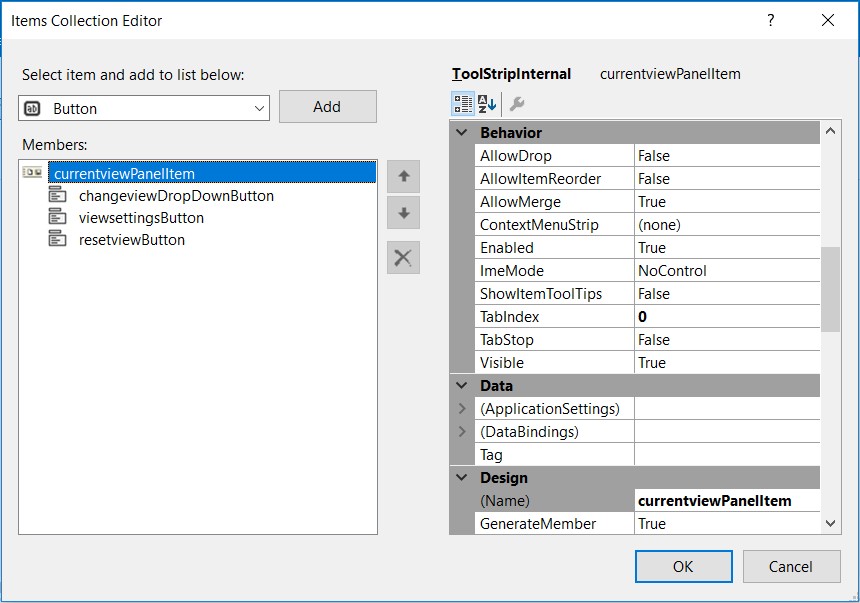
Adding Controls to Panel Item
Accessing ToolStripPanelItem.Items property, Items Collection Editor dialog pops-up. The item can be added and customized using this dialog.
private Syncfusion.Windows.Forms.Tools.ToolStripPanelItem currentViewPanelItem;
private System.Windows.Forms.ToolStripDropDownButton changeViewDropDownButton;
private System.Windows.Forms.ToolStripDropDownButton viewSettingsButton;
private System.Windows.Forms.ToolStripDropDownButton resetViewButton;
this.currentViewPanelItem = new Syncfusion.Windows.Forms.Tools.ToolStripPanelItem();
this.changeViewDropDownButton = new ToolStripDropDownButton();
this.viewSettingsButton = new ToolStripDropDownButton();
this.resetViewButton = new ToolStripDropDownButton();
//Specifies the number of rows in the panel
this.currentViewPanelItem.RowCount = 1;
this.changeViewDropDownButton.Text = "Change\r\nView";
this.viewSettingsButton.Text = "View\r\nSettings";
this.resetViewButton.Text = "Reset\r\nView";
this.currentViewPanelItem.Items.AddRange(new System.Windows.Forms.ToolStripItem[] {
this.changeViewDropDownButton,
this.viewSettingsButton,
this.resetViewButton});
this.currentViewToolStripEx.Items.AddRange(new System.Windows.Forms.ToolStripItem[] {
this.currentViewPanelItem});Private currentViewPanelItem As Syncfusion.Windows.Forms.Tools.ToolStripPanelItem
Private changeViewDropDownButton As System.Windows.Forms.ToolStripDropDownButton
Private viewSettingsButton As System.Windows.Forms.ToolStripDropDownButton
Private resetViewButton As System.Windows.Forms.ToolStripDropDownButton
Me.currentViewPanelItem = New Syncfusion.Windows.Forms.Tools.ToolStripPanelItem()
Me.changeViewDropDownButton = New ToolStripDropDownButton()
Me.viewSettingsButton = New ToolStripDropDownButton()
Me.resetViewButton = New ToolStripDropDownButton()
Me.currentViewPanelItem.RowCount = 1
Me.changeViewDropDownButton.Text = "Change" & vbCrLf & "View"
Me.viewSettingsButton.Text = "View" & vbCrLf & "Settings"
Me.resetViewButton.Text = "Reset" & vbCrLf & "View"
Me.currentViewPanelItem.Items.AddRange(New System.Windows.Forms.ToolStripItem() {Me.changeViewDropDownButton, Me.viewSettingsButton, Me.resetViewButton})
Me.currentViewToolStripEx.Items.AddRange(New System.Windows.Forms.ToolStripItem() {Me.currentViewPanelItem})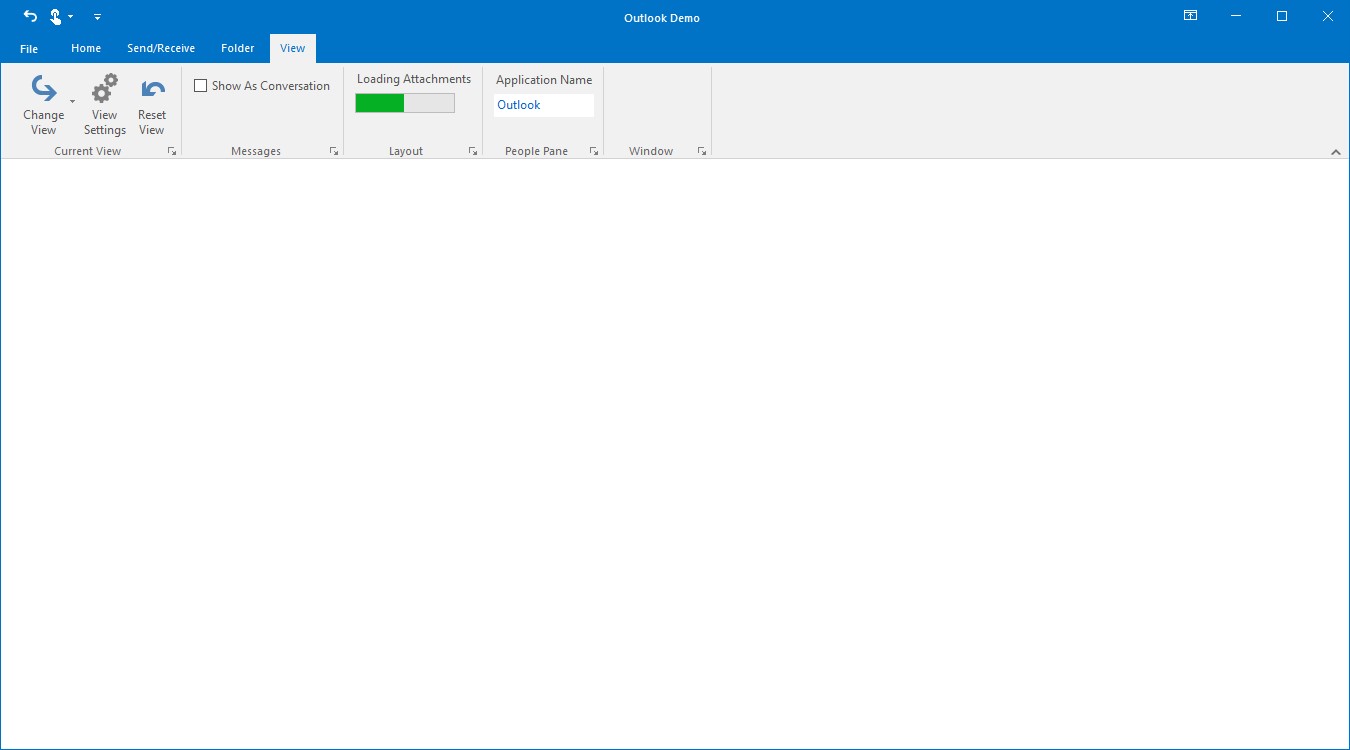
Add QAT
QuickAccessToolBar is a customizable bar that provides one click access to the frequently used items.
By default, the location of QAT will be above the Ribbon, its location can be changed using the property ShowQuickPanelBelowRibbon.
QuickAccessToolBar Items
Adding Items to QAT
QAT item can be added by right clicking the ribbon item and choosing Add to Quick Access Toolbar from the context menu.
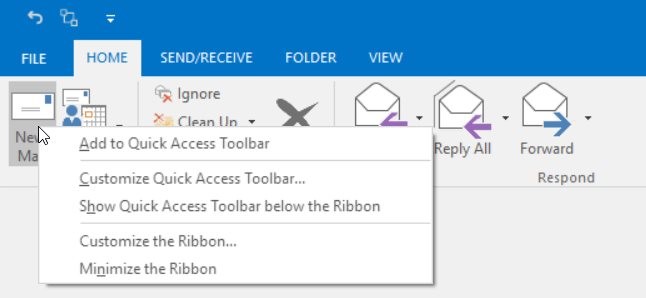
Add BackStage
Ribbon enables you to work in the document and Backstage enables you to work with the document. Using this you can alter contents and provide end-user options that are related to specific solution requirements.
The following are steps to create a BackStageView:
- Drag and drop the BackStageView from the Toolbox.
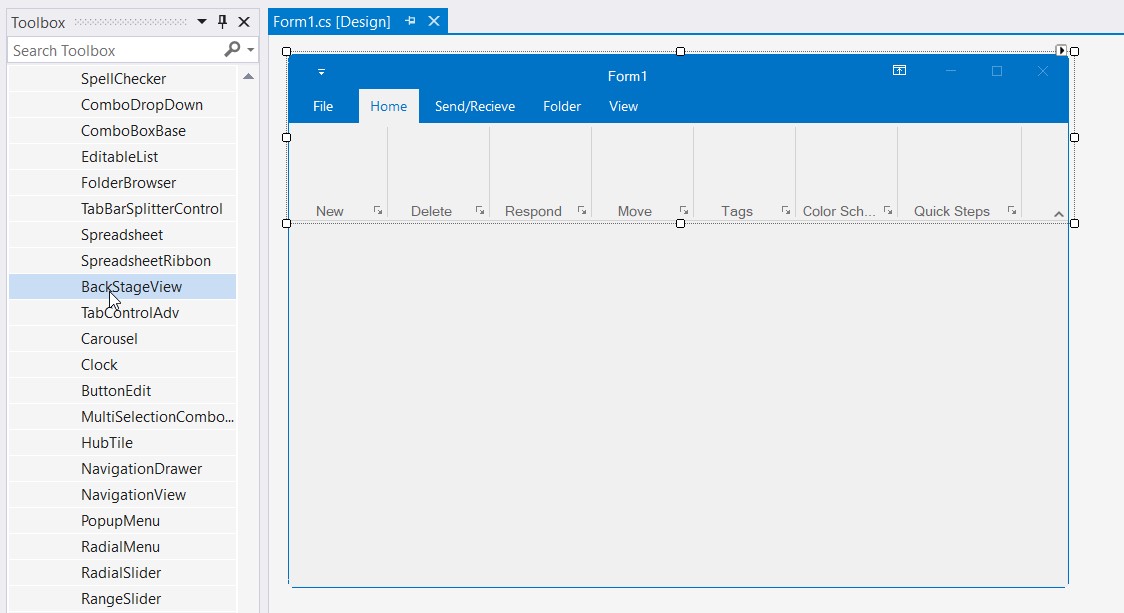
- Select the backStageView control below the designer and click the smart tag from the focus rectangle and then click
ShowBackstage.

- Set BackStageView to RibbonControlAdv

Set a name to the menu button with the property MenuButtonText
this.ribbonControlAdv1.MenuButtonText = "File";Me.ribbonControlAdv1.MenuButtonText = "File"- An Empty BackStage will be created. By clicking the File menu button, BackStage will be shown.

Add BackStage Tab
BackStage Tab can be added through Smart tag of backstage view.

Through Coding
//Creating new backstage tabs
private Syncfusion.Windows.Forms.BackStageTab openExportBackStageTab;
private Syncfusion.Windows.Forms.BackStageTab saveAttachmentsBackStageTab;
private Syncfusion.Windows.Forms.BackStageTab openBackStageTab;
private Syncfusion.Windows.Forms.BackStageTab officeAccountsBackStageTab;
private Syncfusion.Windows.Forms.BackStageTab printBackStageTab;
//Creating new instance and customizing
this.openExportBackStageTab = new Syncfusion.Windows.Forms.BackStageTab();
this.saveAttachmentsBackStageTab = new Syncfusion.Windows.Forms.BackStageTab();
this.openBackStageTab = new Syncfusion.Windows.Forms.BackStageTab();
this.officeAccountsBackStageTab = new Syncfusion.Windows.Forms.BackStageTab();
this.printBackStageTab = new Syncfusion.Windows.Forms.BackStageTab();
this.openExportBackStageTab.Text = "Open/Export";
this.saveAttachmentsBackStageTab.Text = "Save Attachments";
this.openBackStageTab.Text = "Open";
this.officeAccountsBackStageTab.Text = "Office Accounts";
this.printBackStageTab.Text = "Print";
//Adding them to backstage controls
this.backStage1.Controls.Add(openExportBackStageTab);
this.backStage1.Controls.Add(saveAttachmentsBackStageTab);
this.backStage1.Controls.Add(openBackStageTab);
this.backStage1.Controls.Add(officeAccountsBackStageTab);
this.backStage1.Controls.Add(printBackStageTab);Private openExportBackStageTab As Syncfusion.Windows.Forms.BackStageTab
Private saveAttachmentsBackStageTab As Syncfusion.Windows.Forms.BackStageTab
Private openBackStageTab As Syncfusion.Windows.Forms.BackStageTab
Private officeAccountsBackStageTab As Syncfusion.Windows.Forms.BackStageTab
Private printBackStageTab As Syncfusion.Windows.Forms.BackStageTab
Me.openExportBackStageTab = New Syncfusion.Windows.Forms.BackStageTab()
Me.saveAttachmentsBackStageTab = New Syncfusion.Windows.Forms.BackStageTab()
Me.openBackStageTab = New Syncfusion.Windows.Forms.BackStageTab()
Me.officeAccountsBackStageTab = New Syncfusion.Windows.Forms.BackStageTab()
Me.printBackStageTab = New Syncfusion.Windows.Forms.BackStageTab()
Me.openExportBackStageTab.Text = "Open/Export"
Me.saveAttachmentsBackStageTab.Text = "Save Attachments"
Me.openBackStageTab.Text = "Open"
Me.officeAccountsBackStageTab.Text = "Office Accounts"
Me.printBackStageTab.Text = "Print"
Me.backStage1.Controls.Add(openExportBackStageTab)
Me.backStage1.Controls.Add(saveAttachmentsBackStageTab)
Me.backStage1.Controls.Add(openBackStageTab)
Me.backStage1.Controls.Add(officeAccountsBackStageTab)
Me.backStage1.Controls.Add(printBackStageTab)Add BackStage Button
BackStage Button can be added through Smart tag of backstage view.

Through Coding
//Creating new backstage buttons
private Syncfusion.Windows.Forms.BackStageButton saveAsBackStageButton;
private Syncfusion.Windows.Forms.BackStageButton optionsBackStageButton;
private Syncfusion.Windows.Forms.BackStageButton exitBackStageButton;
//Creating new instance and customizing
this.optionsBackStageButton = new Syncfusion.Windows.Forms.BackStageButton();
this.saveAsBackStageButton = new Syncfusion.Windows.Forms.BackStageButton();
this.exitBackStageButton = new Syncfusion.Windows.Forms.BackStageButton();
this.optionsBackStageButton.Text = "Options";
this.saveAsBackStageButton.Text = "Save As";
this.exitBackStageButton.Text = "Exit";
//Adding them to backstage controls
this.backStage1.Controls.Add(optionsBackStageButton);
this.backStage1.Controls.Add(saveAsBackStageButton);
this.backStage1.Controls.Add(exitBackStageButton);Private saveAsBackStageButton As Syncfusion.Windows.Forms.BackStageButton
Private optionsBackStageButton As Syncfusion.Windows.Forms.BackStageButton
Private exitBackStageButton As Syncfusion.Windows.Forms.BackStageButton
Me.optionsBackStageButton = New Syncfusion.Windows.Forms.BackStageButton()
Me.saveAsBackStageButton = New Syncfusion.Windows.Forms.BackStageButton()
Me.exitBackStageButton = New Syncfusion.Windows.Forms.BackStageButton()
Me.optionsBackStageButton.Text = "Options"
Me.saveAsBackStageButton.Text = "Save As"
Me.exitBackStageButton.Text = "Exit"
Me.backStage1.Controls.Add(optionsBackStageButton)
Me.backStage1.Controls.Add(saveAsBackStageButton)
Me.backStage1.Controls.Add(exitBackStageButton)BackStageSeparator – a thin line that separates the neighboring items.
Separator can be added through Smart tag as explained in adding backstage button and tab.
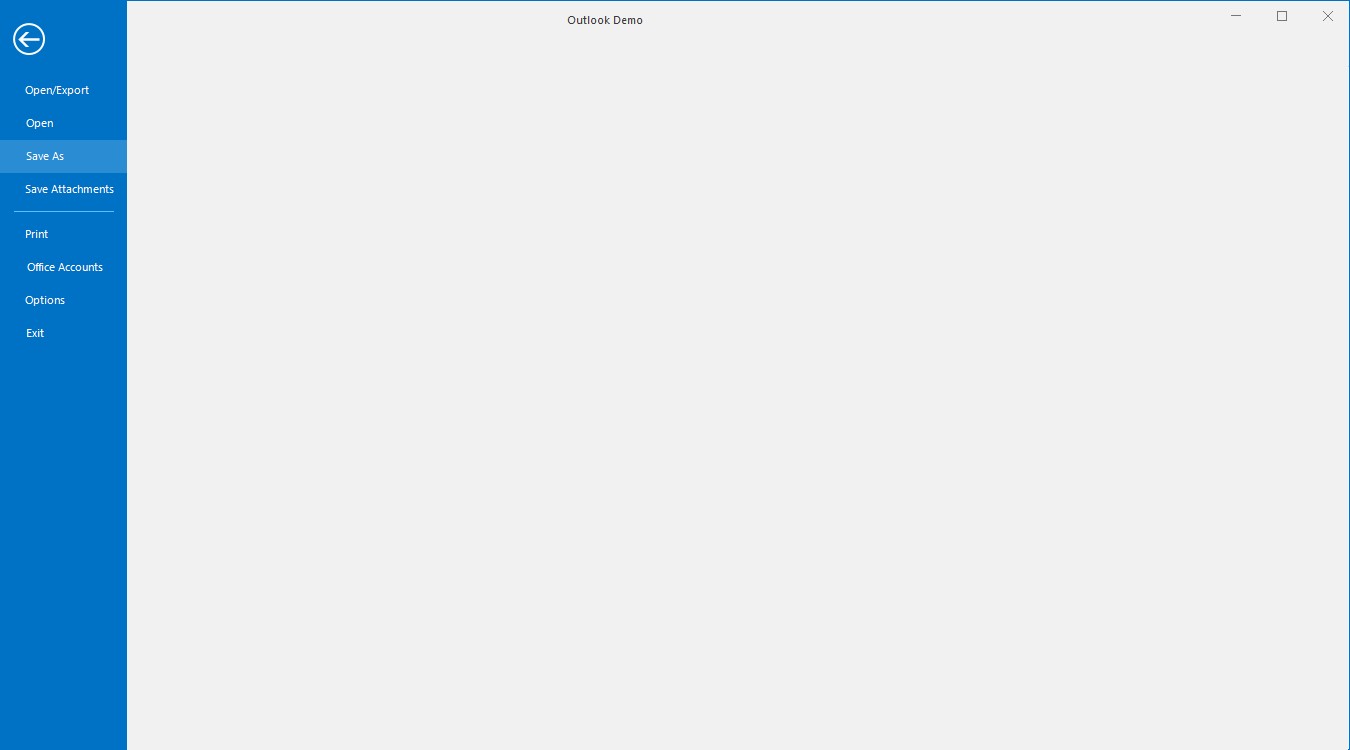
Add ApplicationMenu
The RibbonControlAdv has the office menu button at the top left corner of the form. Controls can be added to the panels of the office menu button dropdown through designer.

NOTE
ApplicationMenu can be accessed only when ribbon style is Office2007
Set simplified layout
The simplified layout is designed to display the most commonly used Ribbon commands in a single line interface, allowing more screen space for compact content viewing, while other commands are placed inside the overflow menu. To know more about the simplified layout, refer here.
NOTE
You can also explore our WinForms Ribbon example that shows how to accommodates all the tools required for an application in a single, easy-to-navigate user interface similar to Microsoft Office.